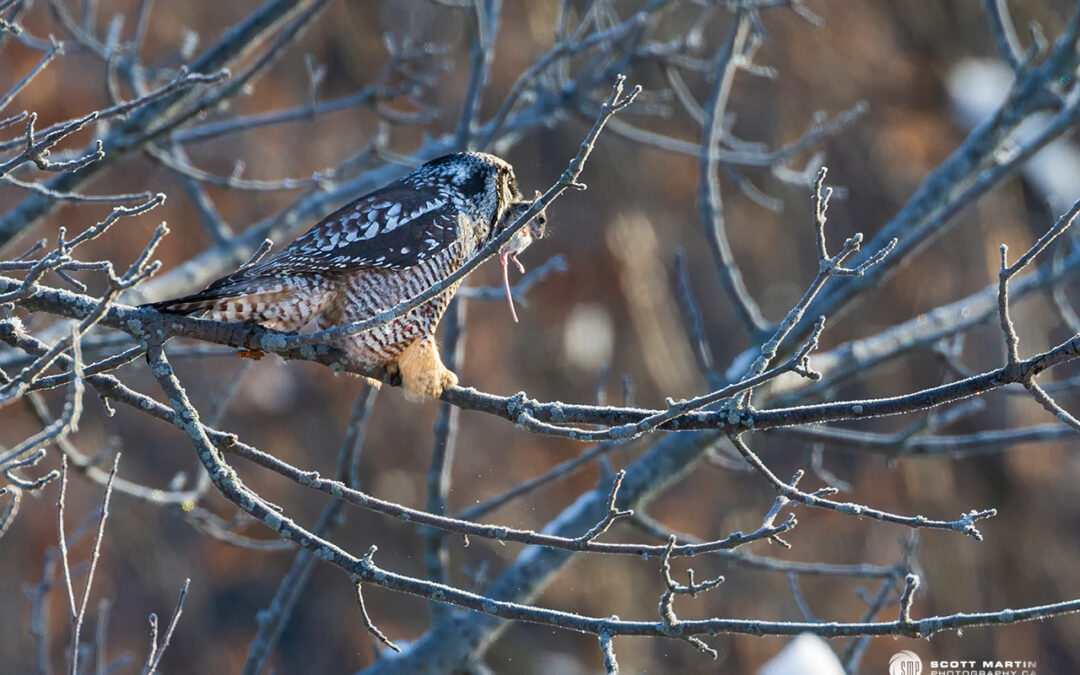
by Scott Martin Photography | Jan 18, 2020 | Birds, Blog, Educational, Raptors, Wildlife
The Northern Hawk Owl is a medium sized owl that typically lives and breeds in the far north. They are rarely seen in south eastern Ontario unless factors such as a lack of food in their native habitat displaces them southward in search of a reliable food source. This winter a lone Northern Hawk Owl has shown up about an hours drive north west of us and it has become quite a celebrity with many birders and photographers making a point of seeing this locally rare bird.
I will prepare another blog post about the Northern Hawk Owl, however with this post I would like to highlight a behaviour that is fairly common amongst raptors; the practice of caching food for future consumption. Northern Hawk Owls are opportunistic diurnal raptors that take prey whenever it presents itself. Thus if the owl captures more food than its immediate nutritional requirements demand it will hide, or cache, that food in a safe place for later consumption. Typical spots for caching food are inside tree cavities or betweens forks of tree branches. It is a behaviour that I was aware of but had never observed until watching this Northern Hawk Owl. It was also a pleasure to be able to catch the caching process with the camera and I trust you enjoy the educational aspect of the images in this post.
The first step for the owl is to catch the prey. Northern Hawk Owls typically hunt voles and small to medium sized birds. The owl caught this vole outside of my view however returned with it to a nearby perch.
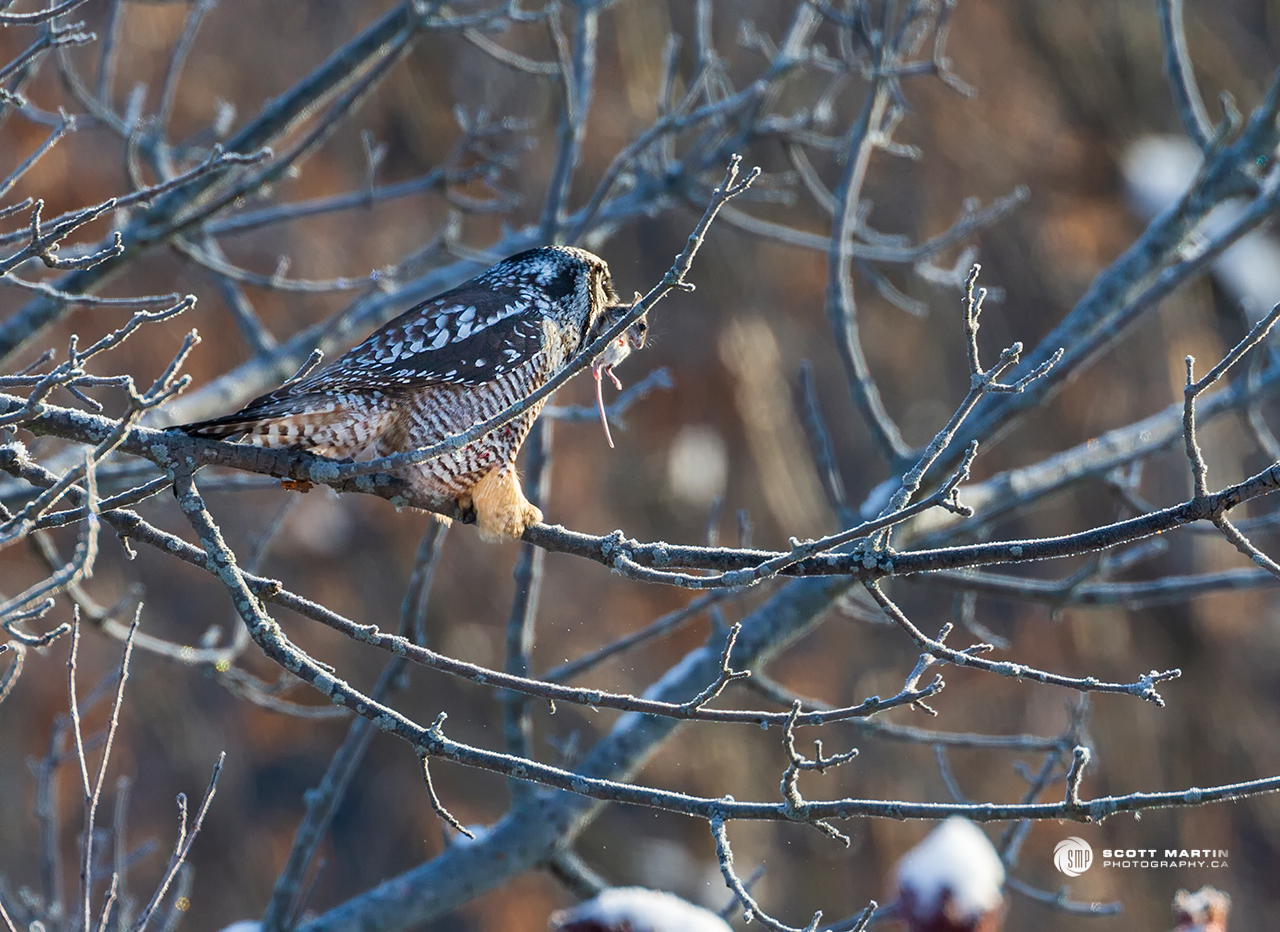
After catching its prey, the owl will often use its wings to spread out around the prey shielding it from the attention of nearby raptors and predators in a behaviour known as mantling. Although not a classic mantling example, you can see in the next image how the Hawk Owl has completely consealed (well, almost) its prey while on its perch.
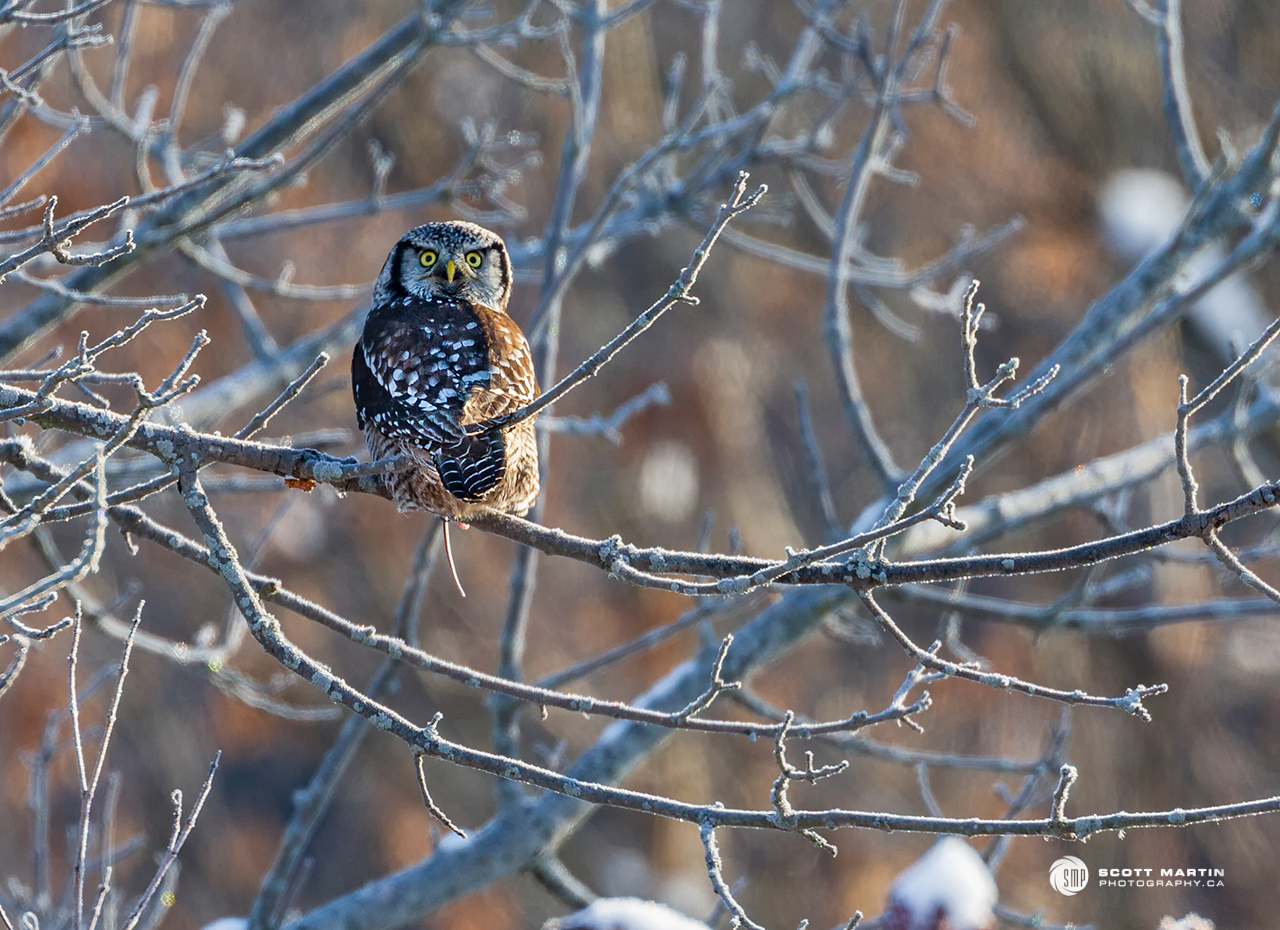
After closely surveying the area and detecting no threats, the owl moved to its chosen cache site in the fork of a small nearby tree.
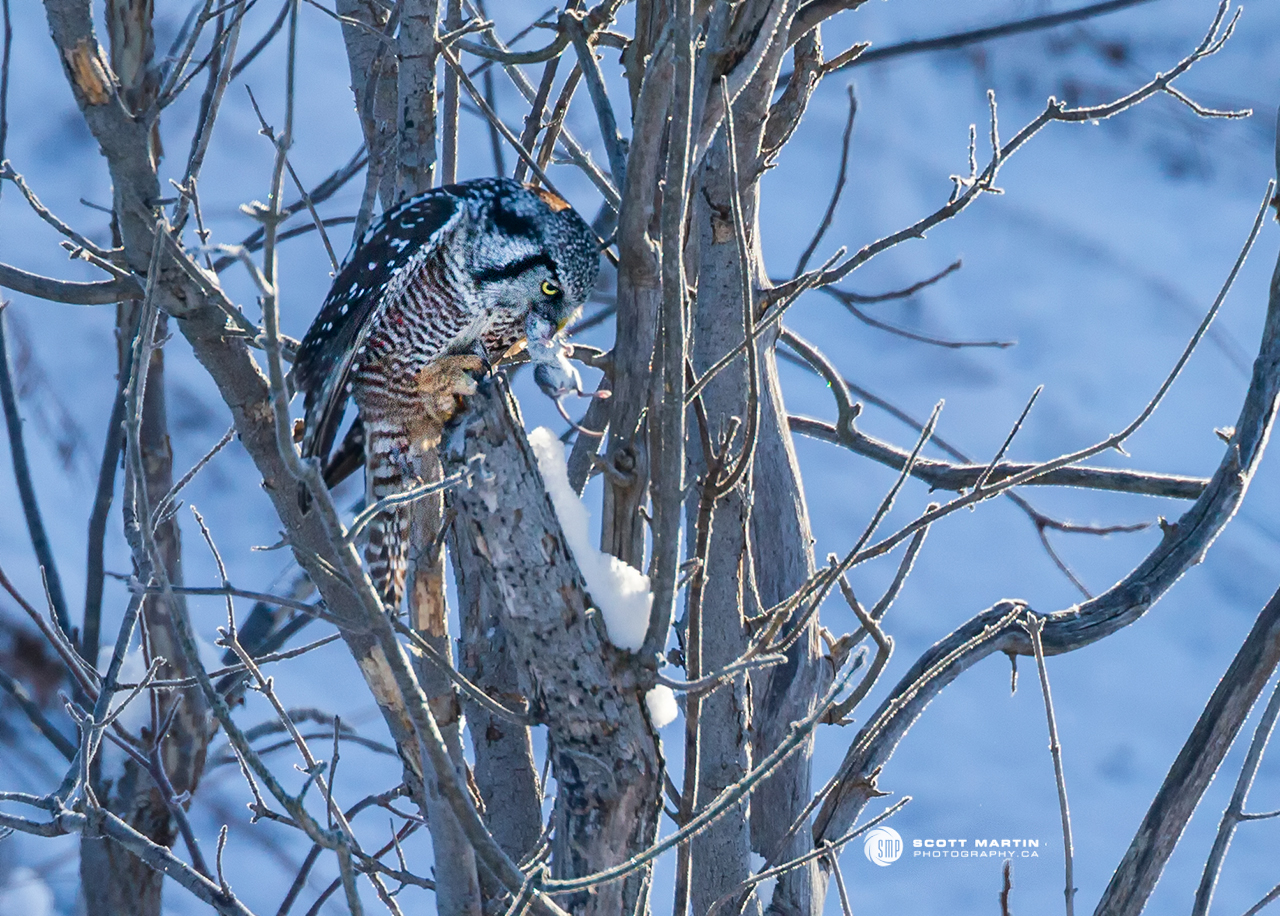
The Hawk Owl deftly and rather forcefully placed the vole into the crook of the tree trunk and branches.
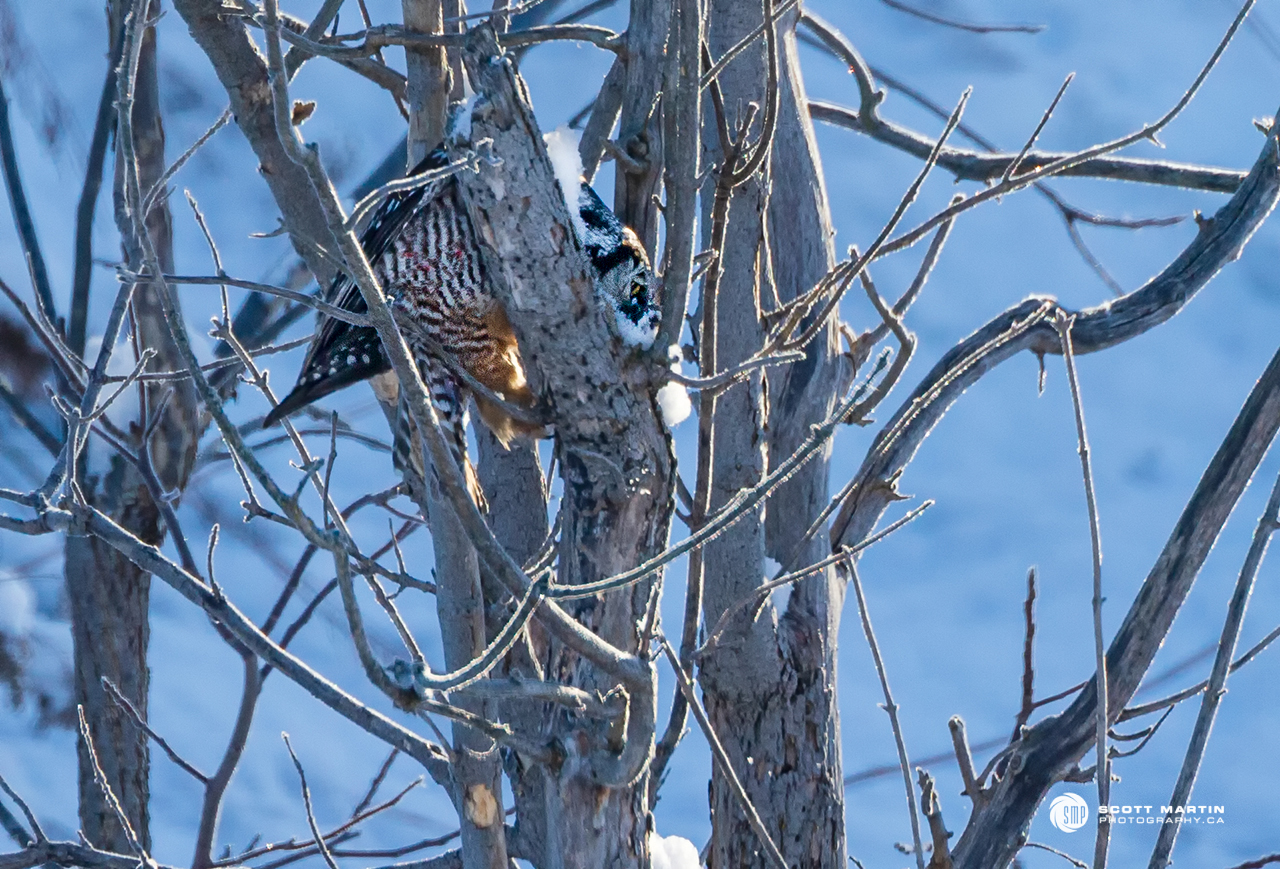
Once the vole was securely placed and well hidden in the tree the Northern Hawk Owl repositioned himself on a nearby perch and immediately began hunting for its next catch.
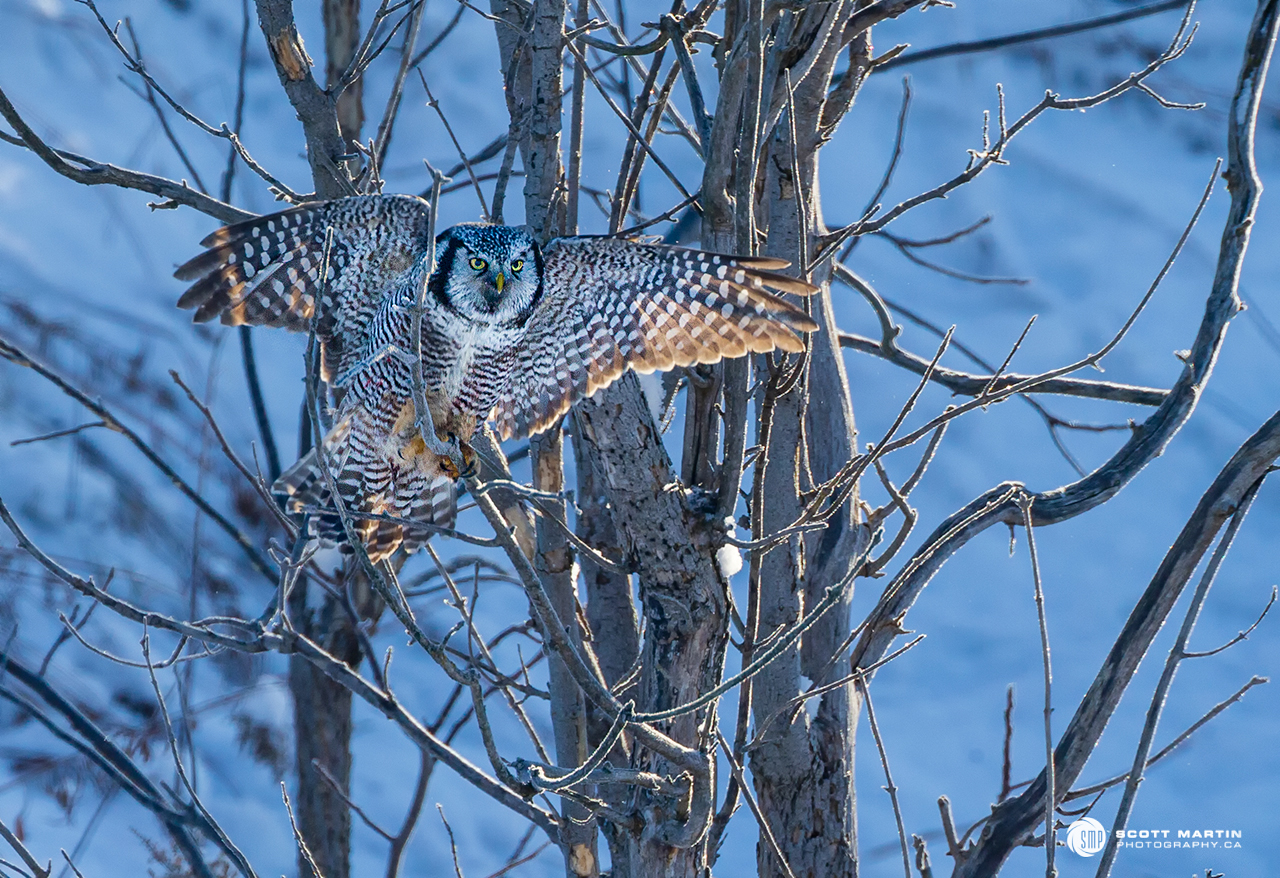
It was interesting to observe that the owl, as well as looking for new food, also kept watch on the locations of its cached food sources. At one point the owl took flight from its perch and travelled about fifty yards to knock a large black squirrel out of a tree that was presumably getting too close to a cached vole. The squirrel fell about 40′ to the ground and didn’t seem to be harmed in the process. The Northern Hawk Owl returned to its original perch and continued to hunt, confident that the squirrel would leave the cache alone. Those of you who have been following this blog will notice two things; its been two years since the last post, and the website looks very differnt now compared to when you last saw it. The old website was so dated in its appearance that I was embarassed to post anything and athough not a good excuse, there just wasn’t enough free time to take the time required to learn how to create a new fresher looking website. Today’s version is better than the old one, however still requires lots of tweaking to get it to where it needs to be. If you find any bugs or have any design suggestions please feel free to leave a comment and I’ll do my best to make the improvements.
Happy New Year to everyone and I look forward to keeping in touch via this website, Facebook or Instagram.
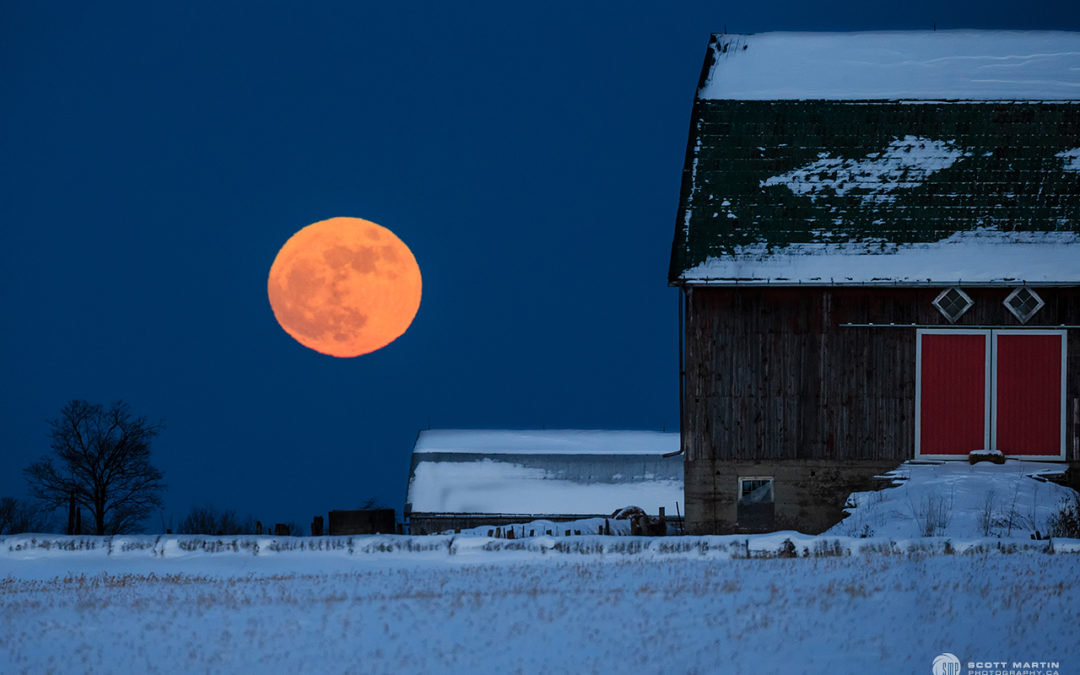
by Scott Martin Photography | Feb 10, 2018 | Blog, Landscapes, Naturescapes, Travel
New Year’s Day 2018 was also a day the moon was featured prominently in the late afternoon sky. It was a ‘Wolf Moon’ (the first full moon in January) and a Supermoon (when a full moon occurs at perigee) making it appear about 7% larger than a typical full moon. The full moon on New Year’s Day meant that a rare second full moon occurred in the same month (on the 31st) which is known as a Blue Moon (hence the term “once in a blue moon”). To make this story even more interesting, the Blue Moon on January 31st was also a total lunar eclipse in the southern America’s (we saw a partial eclipse in Ontario). With all that build up, here is a picture of the full moon on New Year’s Day taken at a farm near Brechin, Ontario shortly after it rose. It was well worth the drive and standing out in the snow in -20°C temperatures to take these few shots.
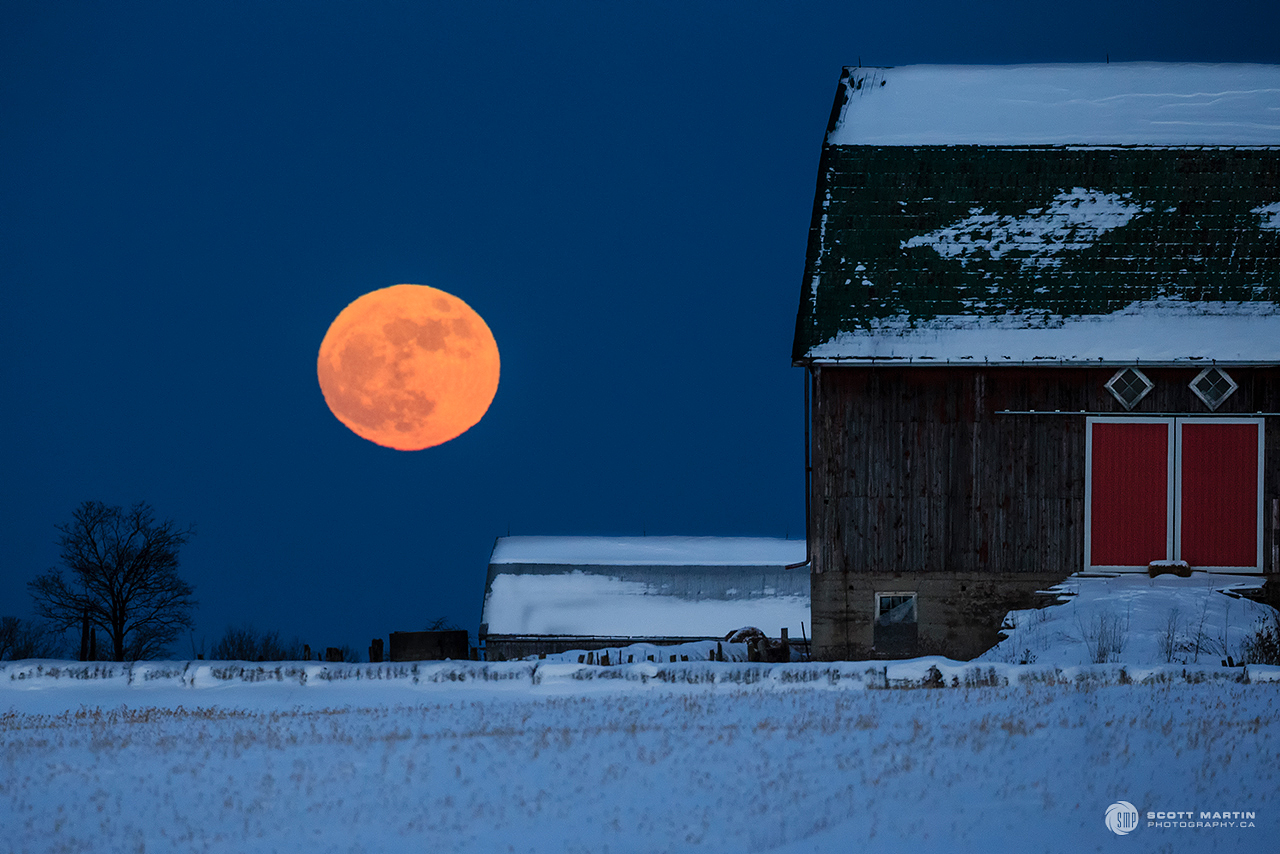
The closest I could park the car was more than 100 yards away so I chose to take just one camera, lens & tripod with me. The lens I selected had a 500mm focal length, which was the wrong lens for the job! After taking just one picture with it (above), I ran back to the car along a snowmobile trail and replaced the big telephoto lens with a more versatile 100-400mm zoom lens which allowed lots of different compositional possibilities!
The above image was taken at a focal length of 300mm.
A focal length of 135mm allowed inclusion of all the farm buildings, however as the focal length decreases, so does the contribution of the moon to the image. It is often difficult in the field to determine exactly what the best composition will be, especially as composition is a very subjective thing. For that reason it is wise to experiment with as many different compositional combinations as possible.
I had to move to the right in order to position the peek-a-boo moon directly over the red barn doors (note the reduced relative size of the outbuilding to the left of the barn), however it makes for a more pleasing composition. The better you can train yourself to think about even the smallest of details while you are out taking pictures is extremely beneficial. It is paying attention to the little things that make would be snapshots become great photographic images.
While walking back to the car with hands and feet far too cold to be taking more pictures, the rustic fence and full moon under the tree branches made me stop for ‘just one more’!
It’s interesting to see how the colour of the moon changes so dramatically as it quickly rises into the sky, beginning a burnt orange as it rises to almost white after about twenty minutes. The influence of the earth’s atmosphere on the sun’s rays when the moon is low in the horizon causes the colour changes. In none of these images was the moon’s colour manipulated during processing. They all appear as they were exposed in the camera.
Sorry there are no Blue Moon or lunar eclipse photographs to post as it was a snowy overcast day with total cloud cover on the last day of January!
Enjoy the winter months and don’t be afraid to take your gear out in the cold to capture some winter landscapes.
As always, if you have any questions, please ask and we will be glad to answer them. Also, I’ve recently opened a new Instagram account just for landscape shots, @smp_landscapes so please follow me there if you are on Instagram. The Instagram account for bird photography is @scottmartinphotography
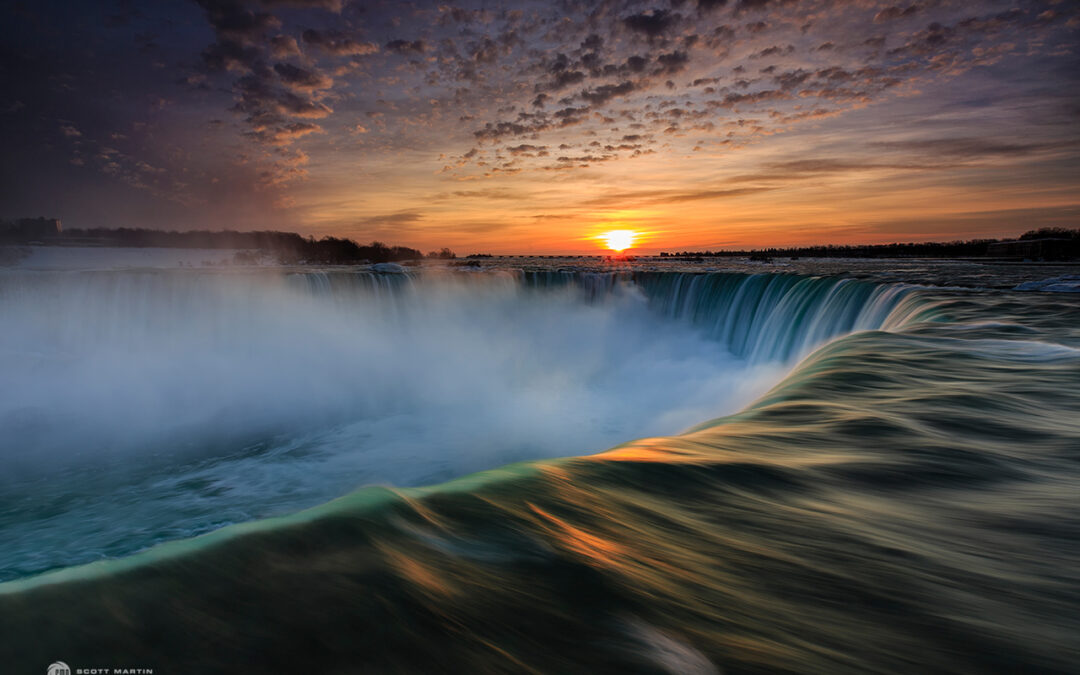
by Scott Martin Photography | Feb 2, 2018 | Blog, Educational, Landscapes, Naturescapes, Travel
For the past number of years we have enjoyed an extended family weekend in Niagara Falls in January. It is a great time of the year to see the falls dressed in her winter splendour with snow and ice abounding and the ever-present mist laminating layer after layer of ice on everything it touches. Also during winter the sun rises over the Horseshoe Falls creating the opportunity for that ‘perfect’ Niagara Falls sunrise photograph.
So on a very cold Saturday morning Deb & I made the short walk from our hotel to the brink of the falls arriving in the dark about twenty minutes before sunrise. It’s wise to arrive early for three reasons; you will likely be first on scene and thus the prime spot to take the image is available (the early bird…), you have time to scout out and determine the best vantage point, and you have time to set up your gear and take test images to determine the correct, perspective, composition and exposure details to successfully record the image you have in mind.
With your smartphone it is possible to do much of the advance planning long before you arrive on the scene. There are many apps that help in this process and after testing many of them my two favourites are LightTrac and PhotoPills. LightTrac is a great little app that allows you to see rise and set times for the sun and moon on any date anywhere in the world. PhotoPills is a very robust app that is essential for every landscape photographer. It allows you to determine where and when the sun or moon will be positioned where you desire and how to position yourself to photograph it. PhotoPills also provides a wealth of information to help calculate complex photographic challenges including time lapse, long exposure and HDR (High Dynamic Range) photography.
Once we pinpointed our location and set up the tripod, we waited patiently for the sun to rise, very happy that there were some clouds in the sky and the wind was sufficient to be blowing the mist from the falls away from the spot where the sun was going to rise.
Sunrise, January 20, 2018
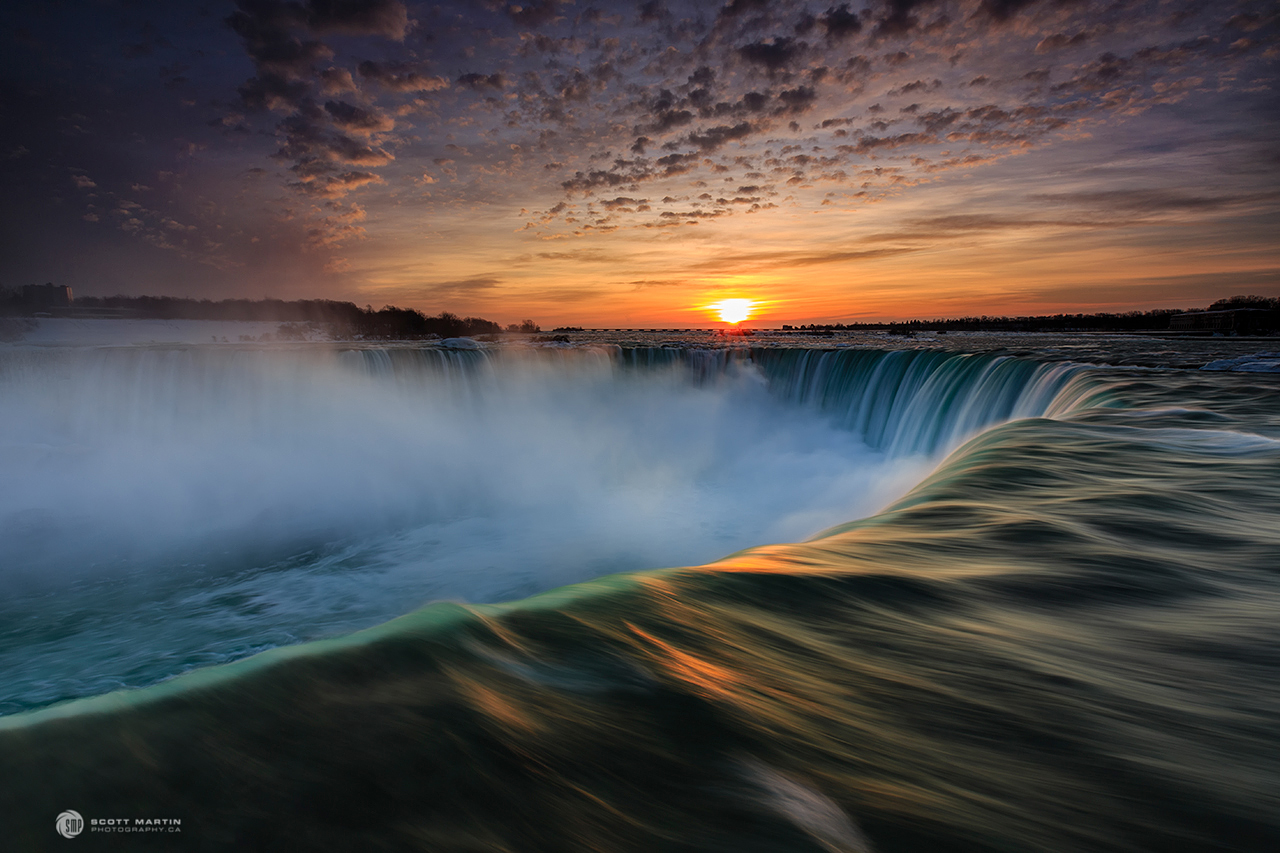
This image was taken using a Canon 5D Mk III with an EF 16-35mm f/2.8L III lens; ISO 50, f/22, 1/2 sec at 16mm focal length. I was able to take this image with a single frame by using a Singh Ray reverse three stop ND grad filter to darken the sun by three f-stops which evens the light intensity at the camera sensor. Without the filter, in order to get a well exposed image you would require at least two images, one exposed for the bright sky and the other for the darker falls and combining them later on the computer. It’s always easier and less time consuming to take one image and filters help make that possible.
After capturing a ‘few’ sunrise images we wandered around the falls enjoying a great start to new day. Making more memories of Niagara Falls on a cool winter’s morning before heading back to the hotel for breakfast. I hope you enjoy these images.
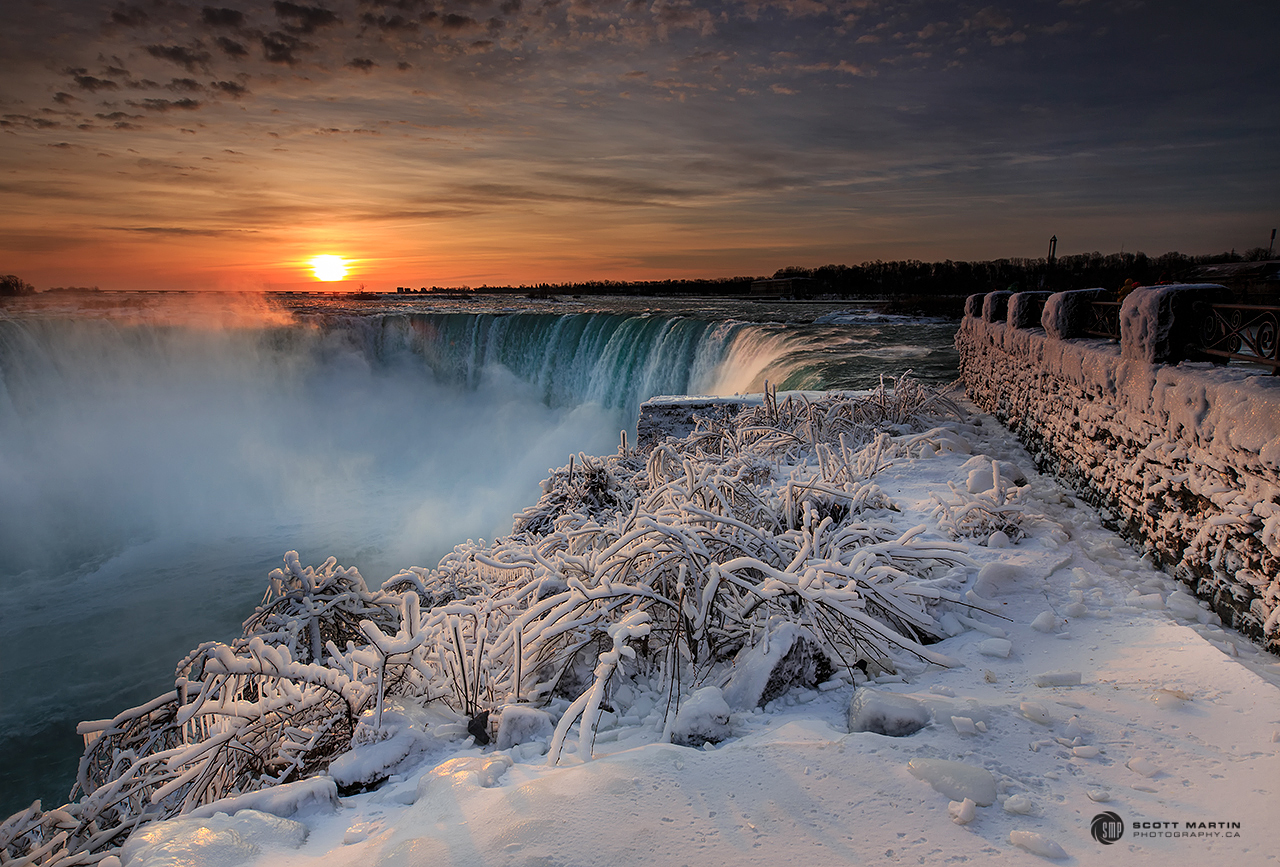
.
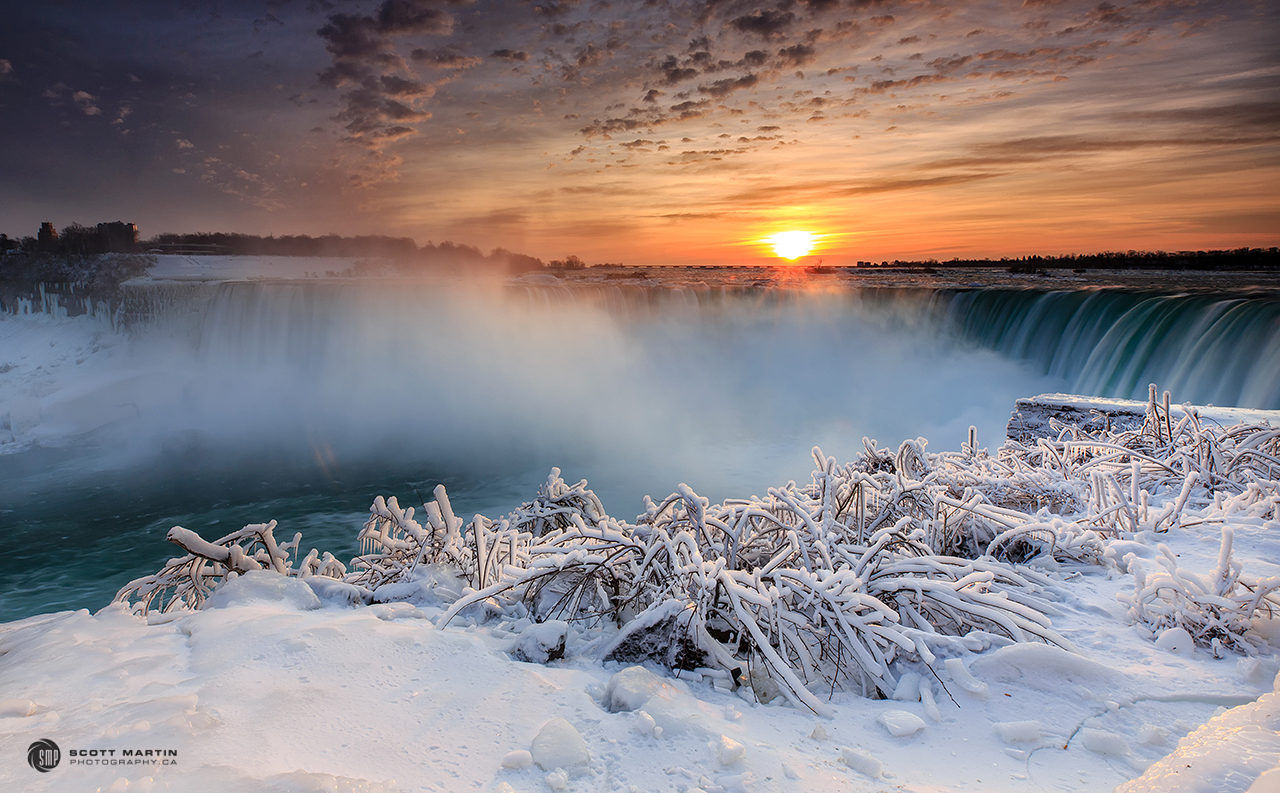
.
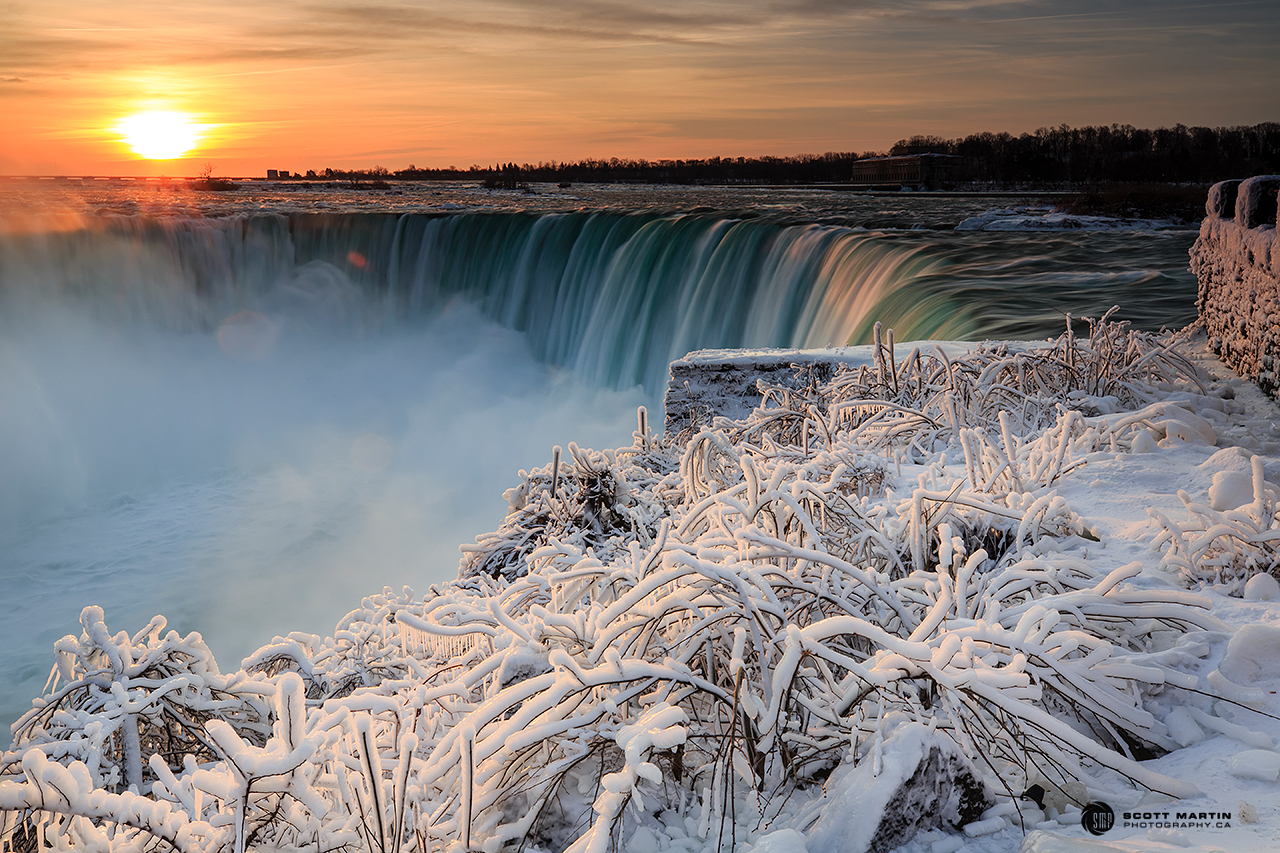
.
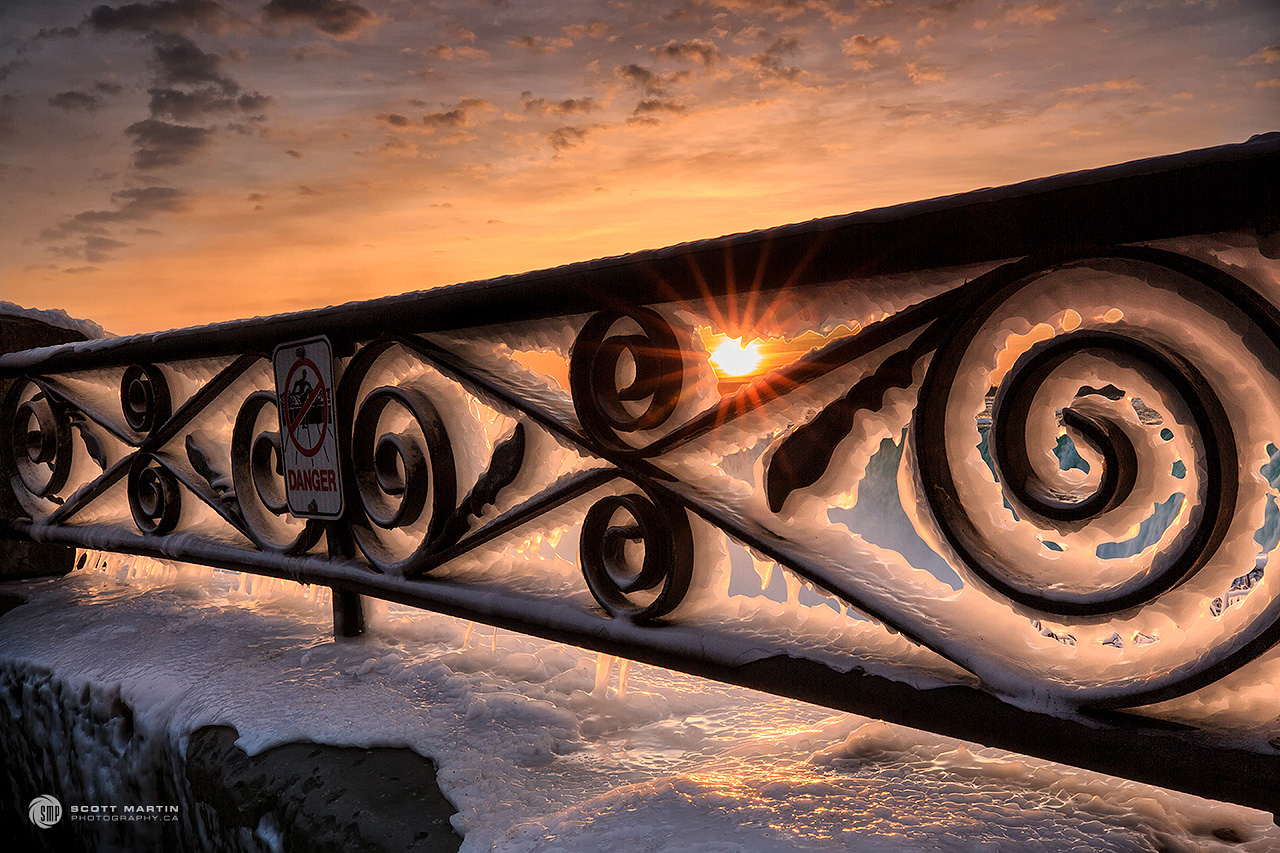
.
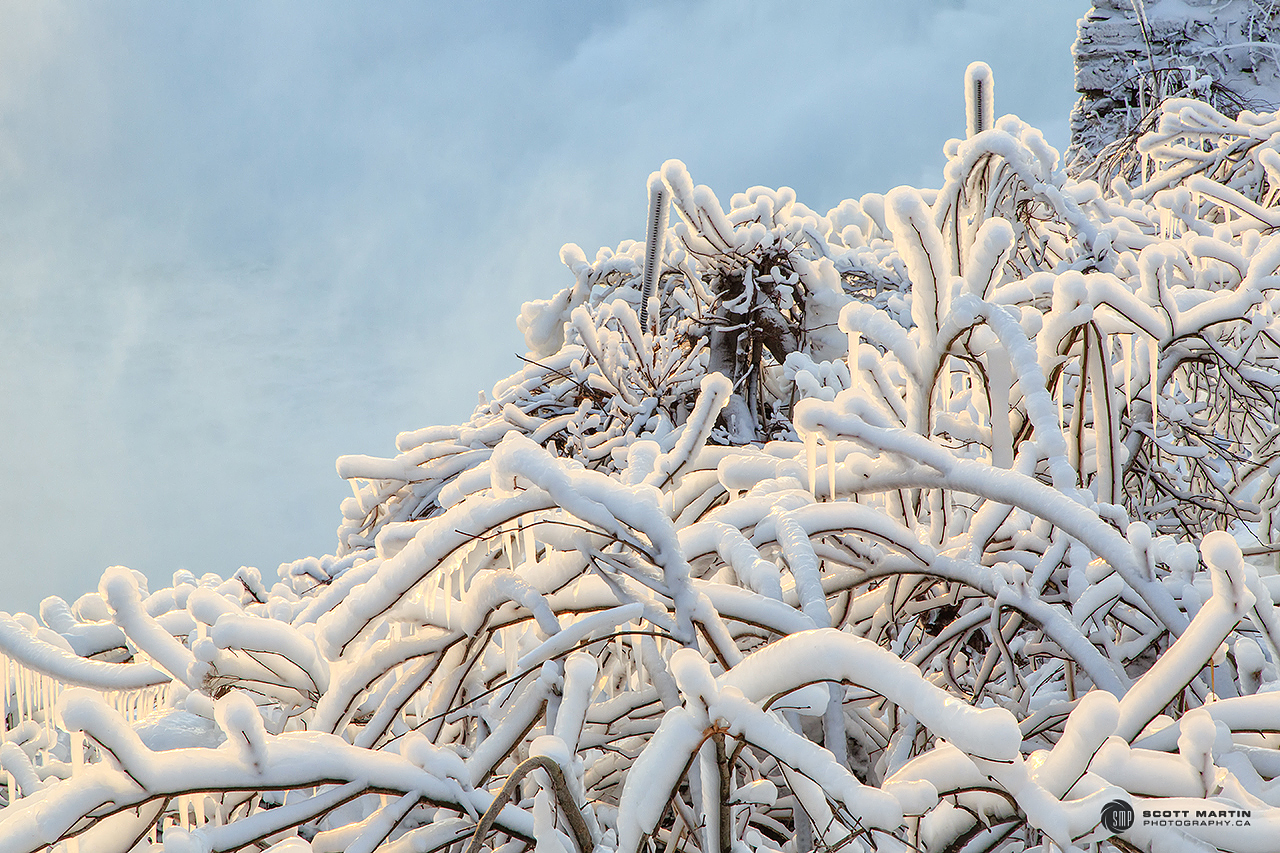
.
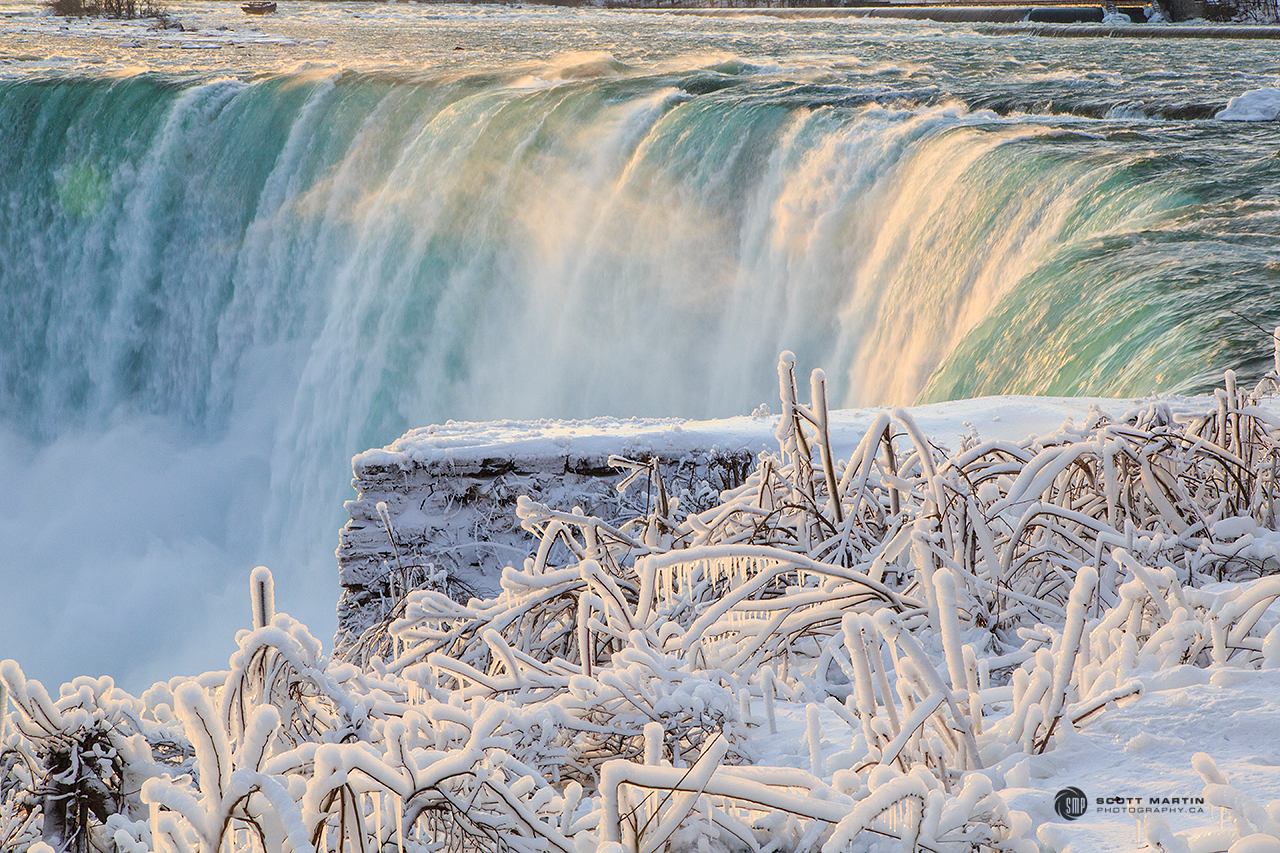
.
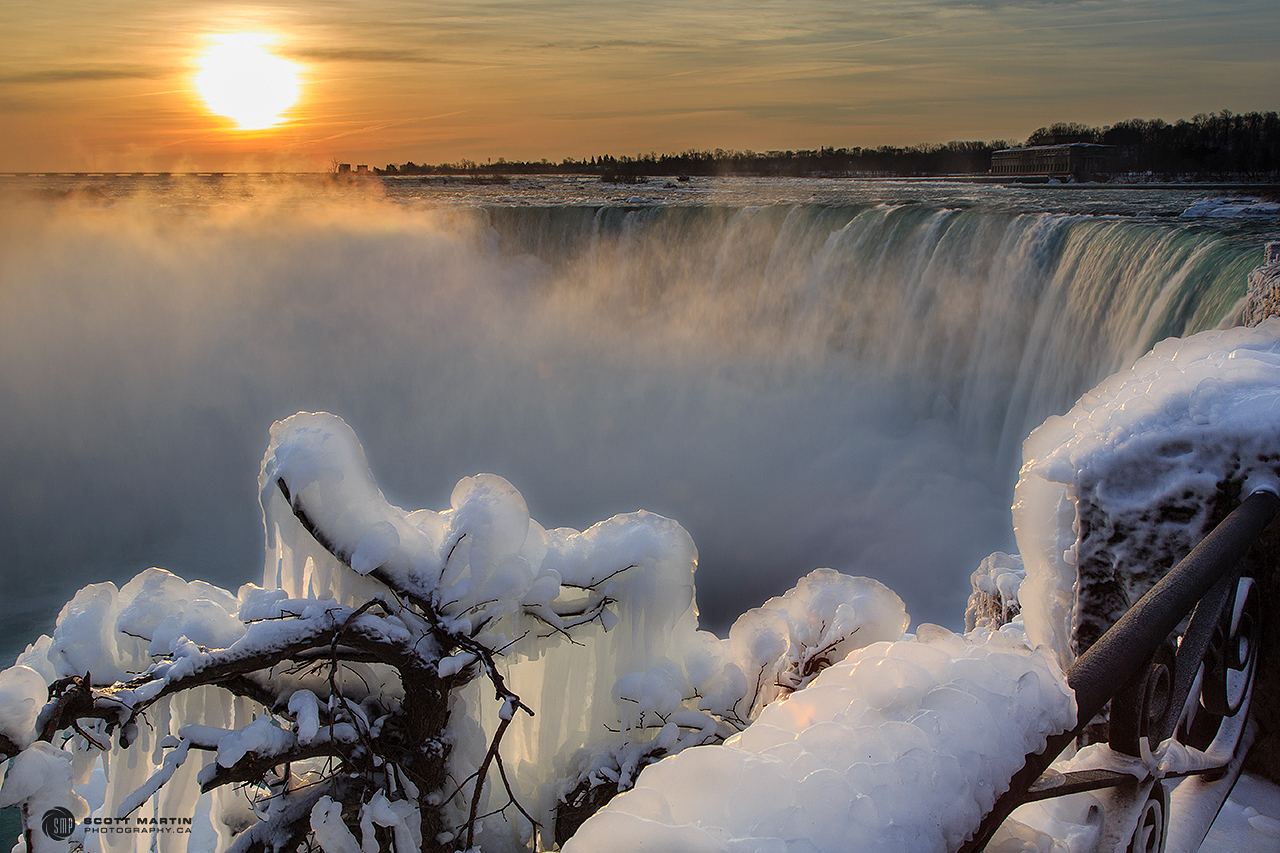
.
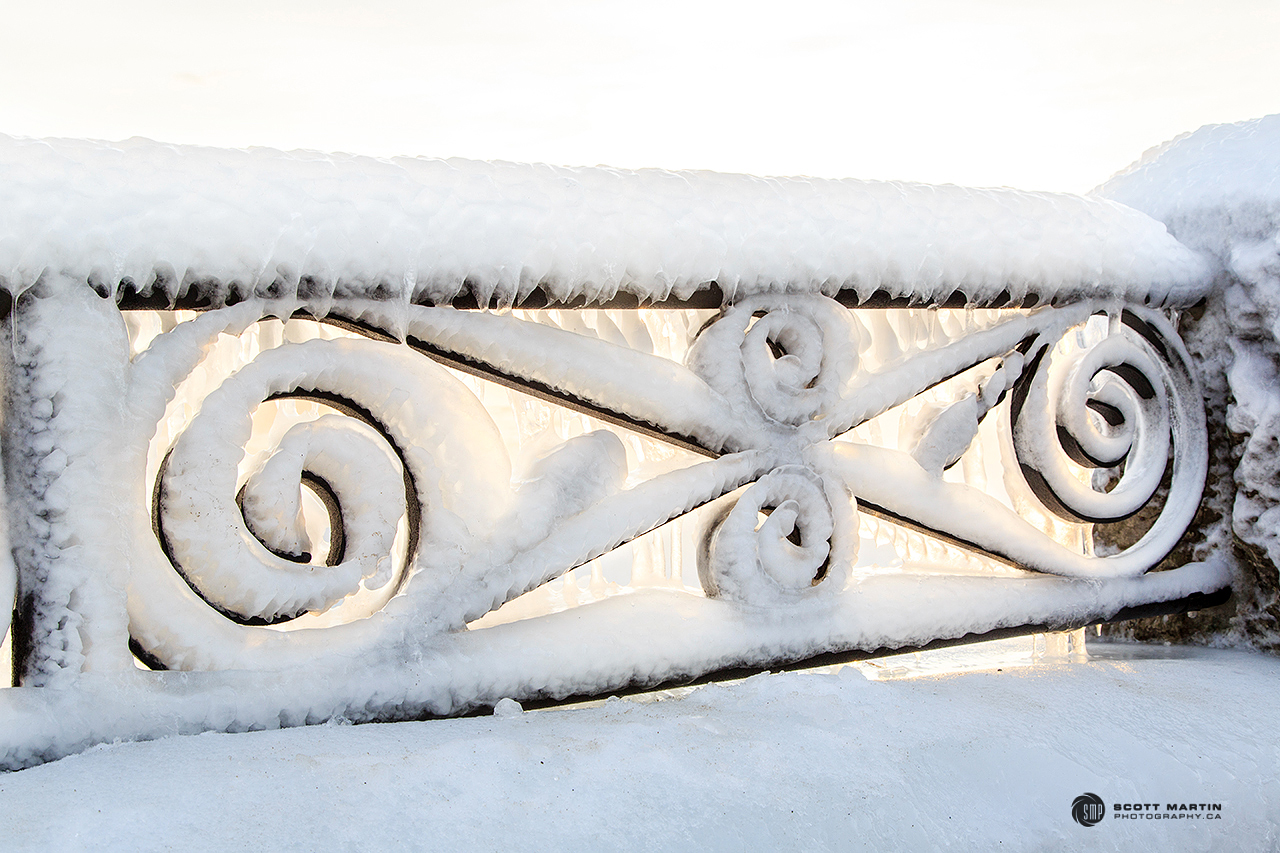
The view from our hotel room.
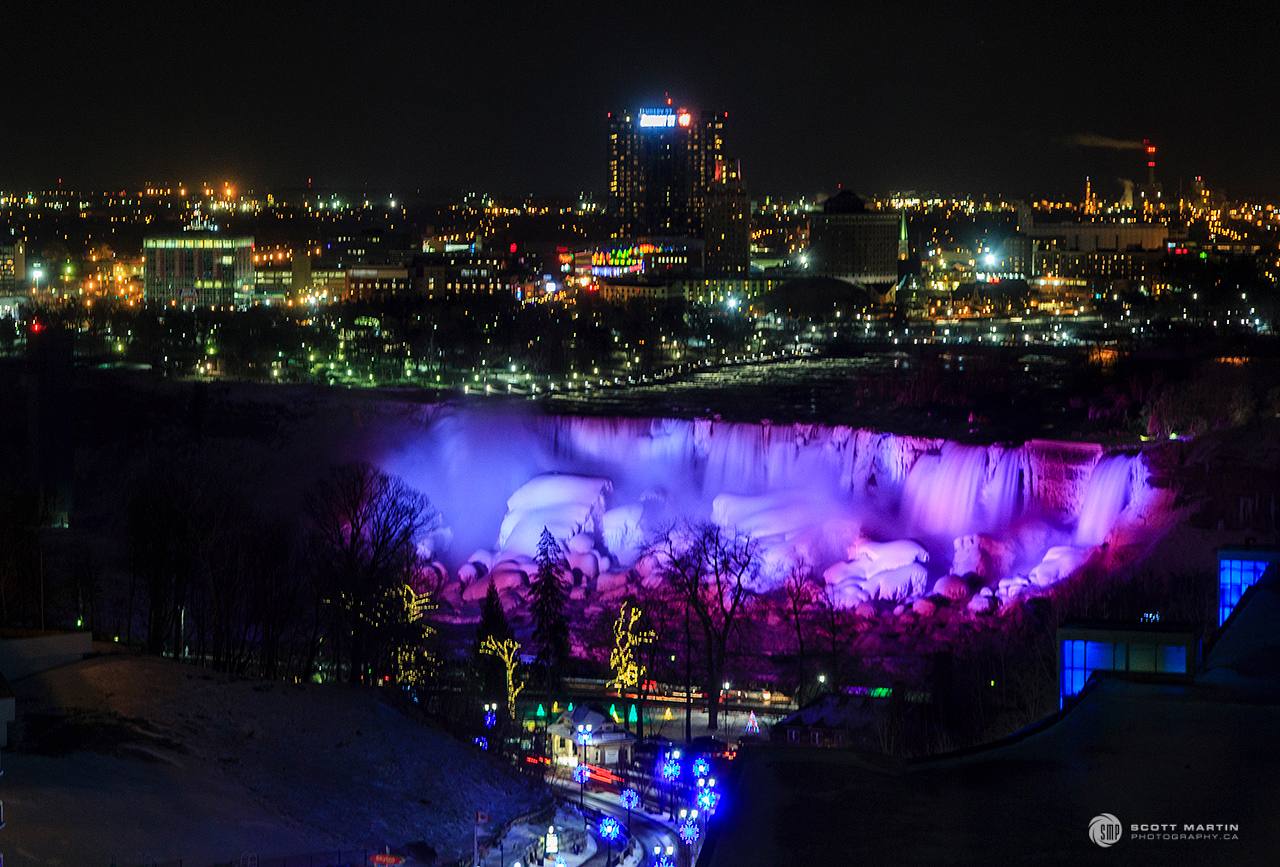
Other images taken at the falls can be seen in the Naturescapes Gallery on the website.
As always, your comments and questions are welcomed and I trust that you will grab a tripod and camera and head out early one morning soon to photograph the sunrise. You will be glad you did.
Although this is a little late, Happy New Year and all the best in 2018 to you and yours!
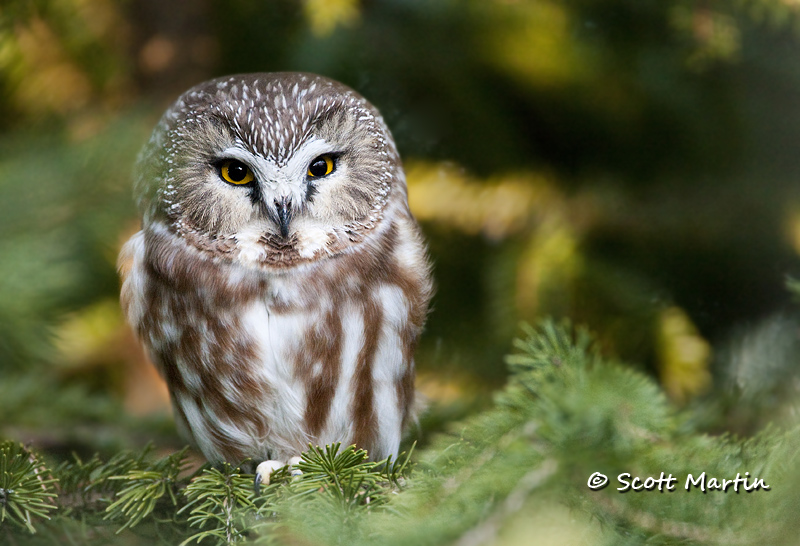
by Scott Martin Photography | Dec 30, 2017 | Birds, Blog, Educational, Raptors, Wildlife
The Survey Period Has Ended. Thank You For Your Interest.
Each year as the cold weather moves in and winter arrives, those of us who count ourselves as birders, photographers or a combination of thereof look forward to seeing owls, especially those that make their way south from the Arctic in search of food. In our area (Southern Ontario) the Snowy Owl is the most common followed by the Great Gray Owl and even more elusive Northern Hawk Owl.
It is also the time of year that the topic of discussion on many birding and photography forums as well as other social media platforms turns to the subject of baiting, specifically the baiting of raptors. These discussions are often emotionally charged and it has been my observation that little is accomplished by them.
If you search the literature there is not a plethora of information regarding baiting, especially with respect to the modes of baiting nor any objective parameters to even define what constitutes baiting. It is no wonder baiting discussions take the course they do.
The desire to gather information that will provide context for future baiting discussions became the genesis for this survey. It has been in development for a while and I greatly appreciate the input and edits suggested by five respected colleagues (including birders, conservationists and photographers) who reviewed the survey prior to its release.
The survey will remain open through January 31, 2018 with results available shortly afterwards. Please invite others to complete the survey and feel free to promote it among groups you interact with.
The Survey Period Has Ended. Thank You For Your Interest.

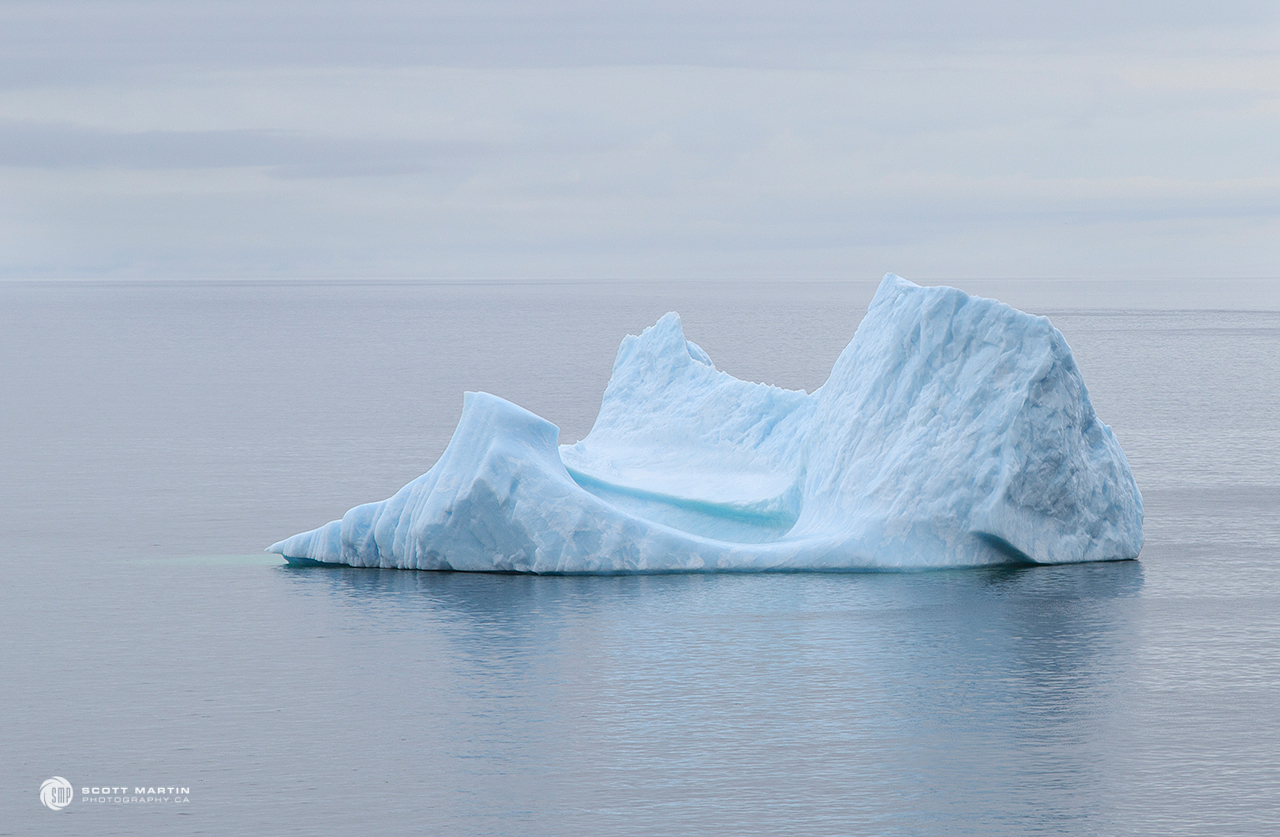
by Scott Martin Photography | Dec 5, 2017 | Blog, Landscapes, Naturescapes, Travel
This past summer Deb & I visited Newfoundland for the first time. It was a magical place to explore and happily we were able to see and photograph the wonderful geography, historic lighthouses and quaint villages as well as three unpredictable things we had hoped to see, namely icebergs, Puffins and whales.
This year was one of the best in recent memory to see icebergs in Newfoundland due to the large numbers present and how late into the summer the pack ice remained before breaking up and freeing the mighty icebergs to drift out to sea. This allowed Deb & I to see a few icebergs at the end of July, more than a month later than usual. We had planned the timing of our visit to see Puffins and whales which made the likelihood of seeing icebergs slim, however as we daily monitored IcebergFinder in the weeks prior to our trip we were excited to find that we just might see some. (Bookmark the IcebergFinder link if you ever plan to visit Newfoundland and want to know where the icebergs are).
While staying in Twillingate, part of the region known as Iceberg Alley along the North Coast of the island, we heard a large iceberg was just a few kilometres away in Crow Head. Neither Deb nor I had ever seen an iceberg and will never forget the feeling of cresting a hill heading into the village and seeing a huge iceberg sitting majestically just off shore. I had to stop the car and take a pic 🙂
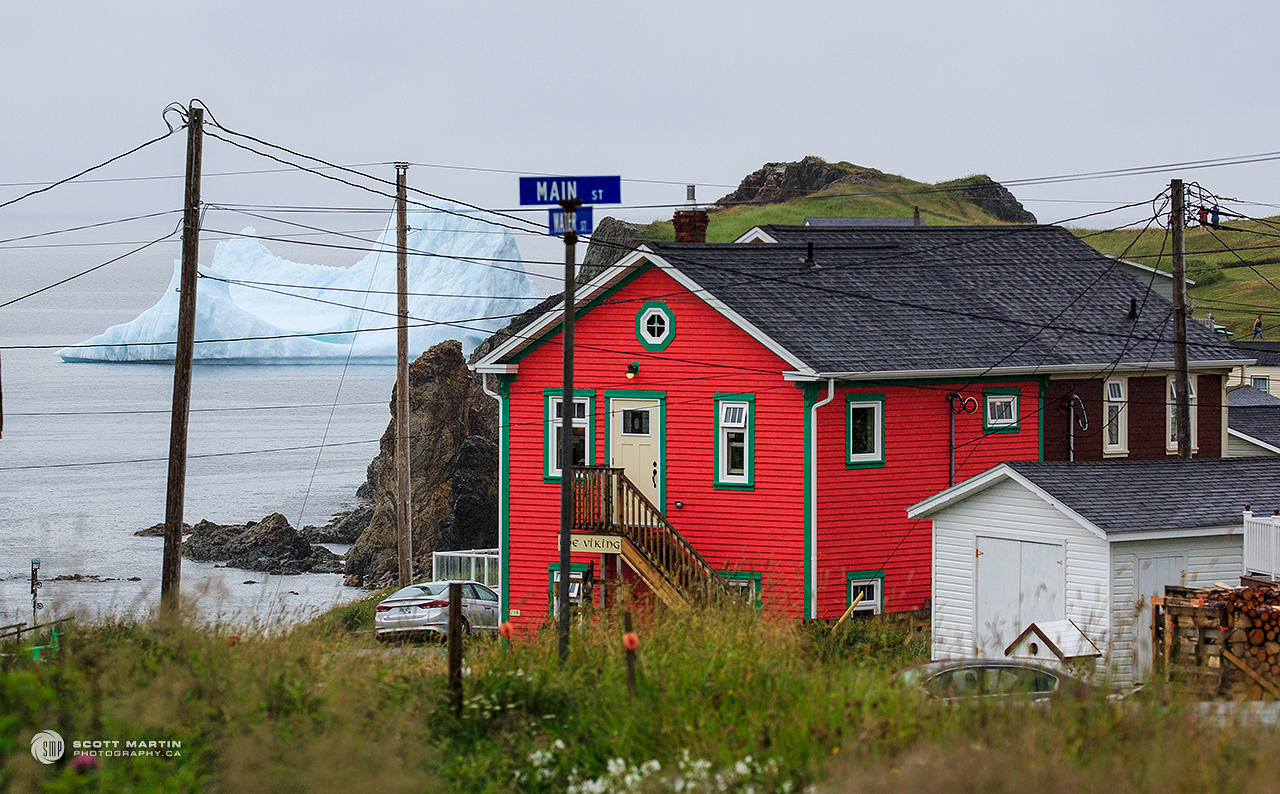
We quickly made our way to a great vantage point to see and photography the iceberg.

Icebergs are formed when they calve off a glacier and typically survive for three to six years before passing out of existence. Most icebergs in Newfoundland are formed when they break off glaciers in Greenland and currents take them southwest where they encounter the Labrador Current which they follow until they physically break apart due to the erosive action of the wind and waves or simply melt as they stray into warmer waters.
We were thrilled to see a Minke whale slowly swim behind the iceberg and give a bit of context to the size of the iceberg. Minke Whales are up to 30′ long and the locals were saying the iceberg was 200′ wide and 75′ high. It was grounded in 580′ of water! Take note of the iceberg water level in this picture and compare it with the images to follow.
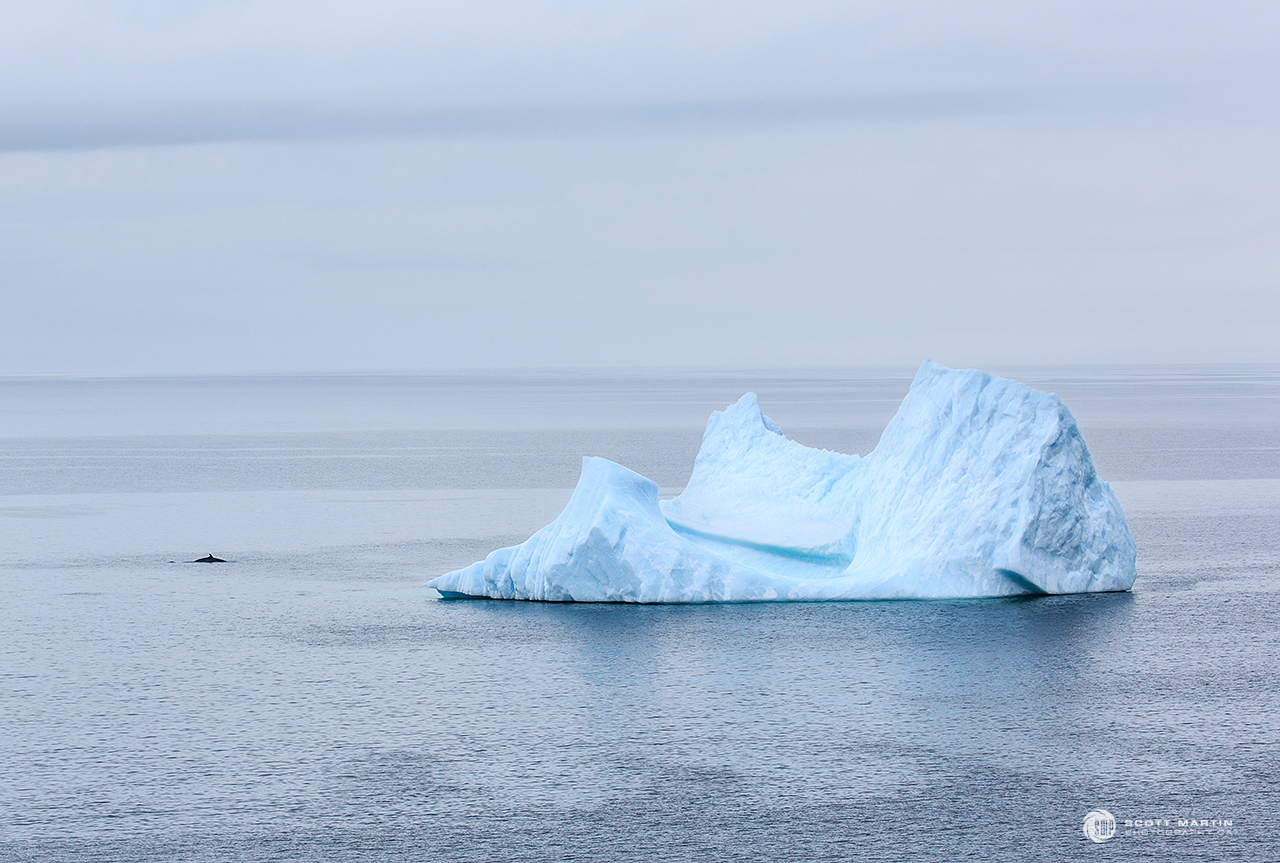
These two kayakers, much braver than Deb or I, also provide some context, but have you noticed the changing water levels….the iceberg was destabilizing and starting to roll!
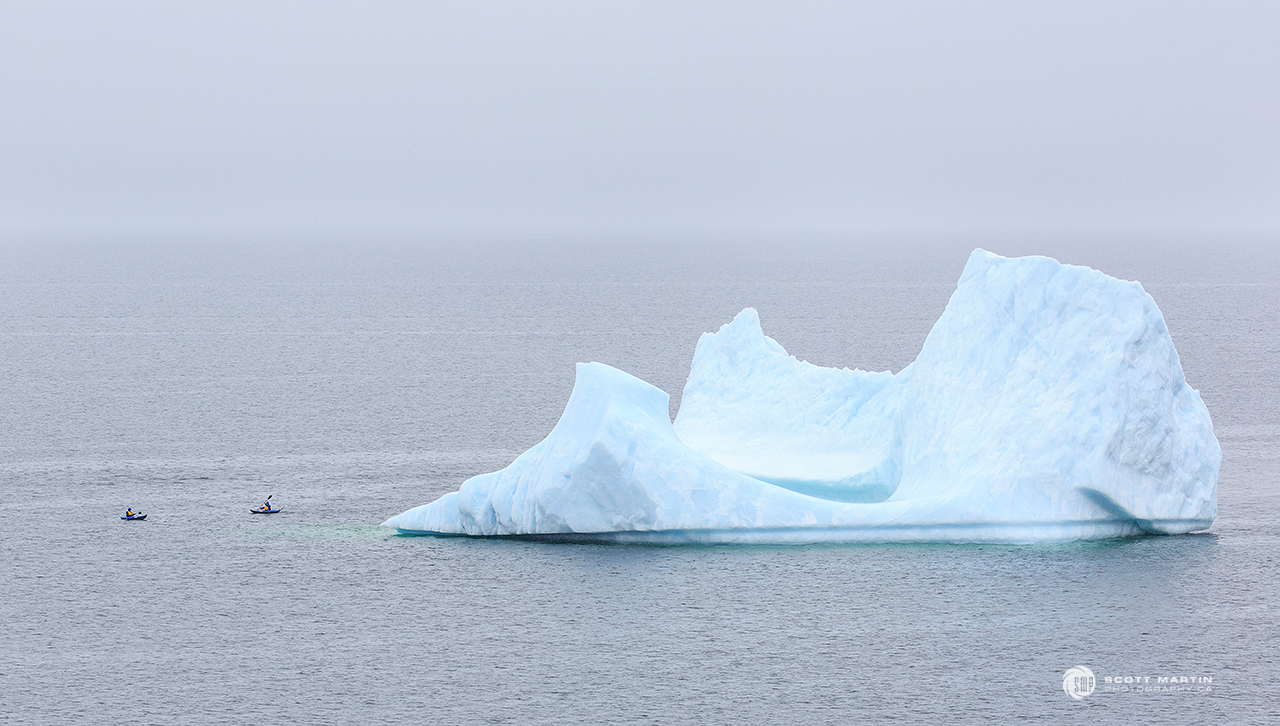
As the iceberg moves, the weight distribution is altered which can cause the iceberg to fragment as seen in this next image. The sound of ice breaking away from the iceberg and splashing into the water is like nothing we had ever heard; like the combination of a rifle shot with thunder.
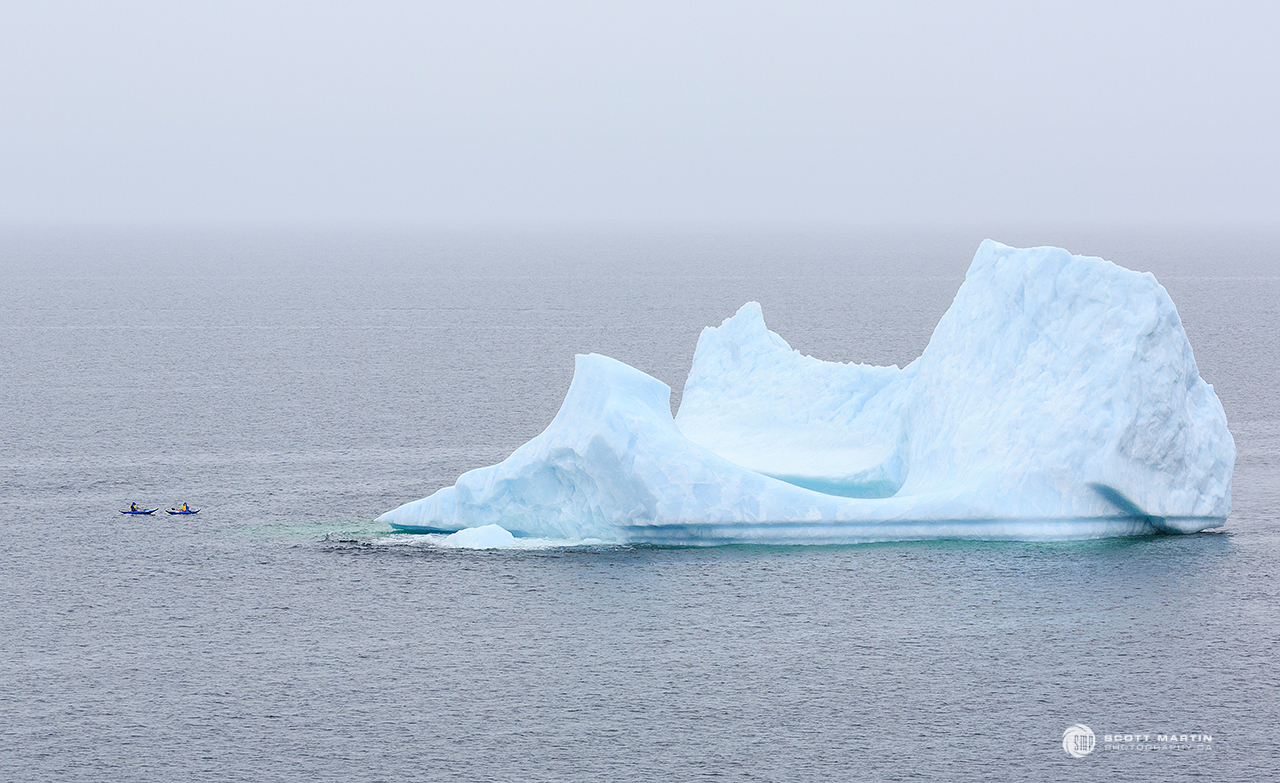
Once the iceberg began to fragment, the process continued and less than five minutes after the first piece of ice fractured and even larger segment fell off the back of the iceberg. Check the water level marks and note how much the ice mass was moving.
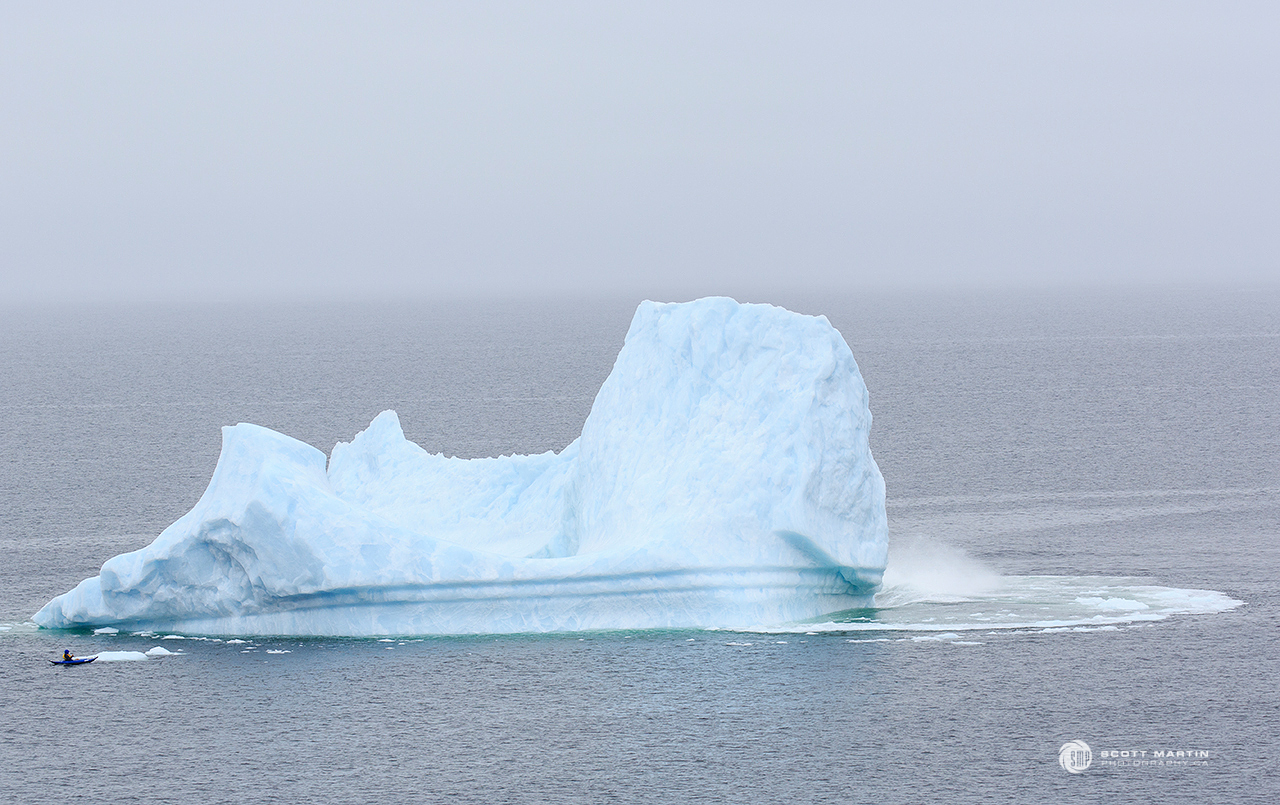
I can only imagine what it would have been like to be in a kayak while an iceberg was breaking up around me!
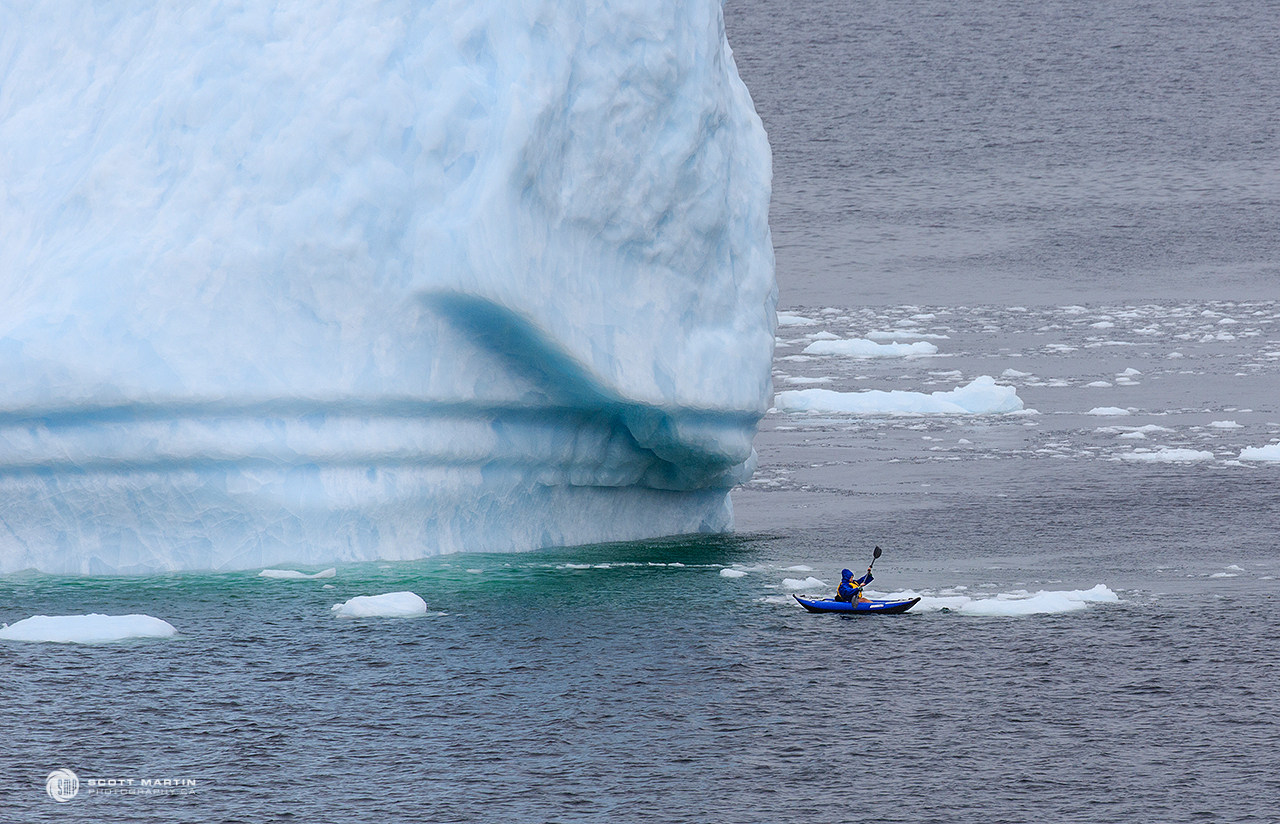
Although we didn’t try a kayak, we connected with Iceberg Man Tours in Twillingate for a two hour cruise highlighted with a visit to the iceberg. Captain Cecil was terrific and we learned so much about Newfoundland, the culture, the whales and the icebergs during our cruise. Captain Cecil is a retired teacher, who grew up in Twillingate, served as mayor of Twillingate and started Iceberg Man Boat tours in 1985. Cecil knows Newfoundland!
The little village of Crow Head, NL as seen from amongst ice fragments around the iceberg.
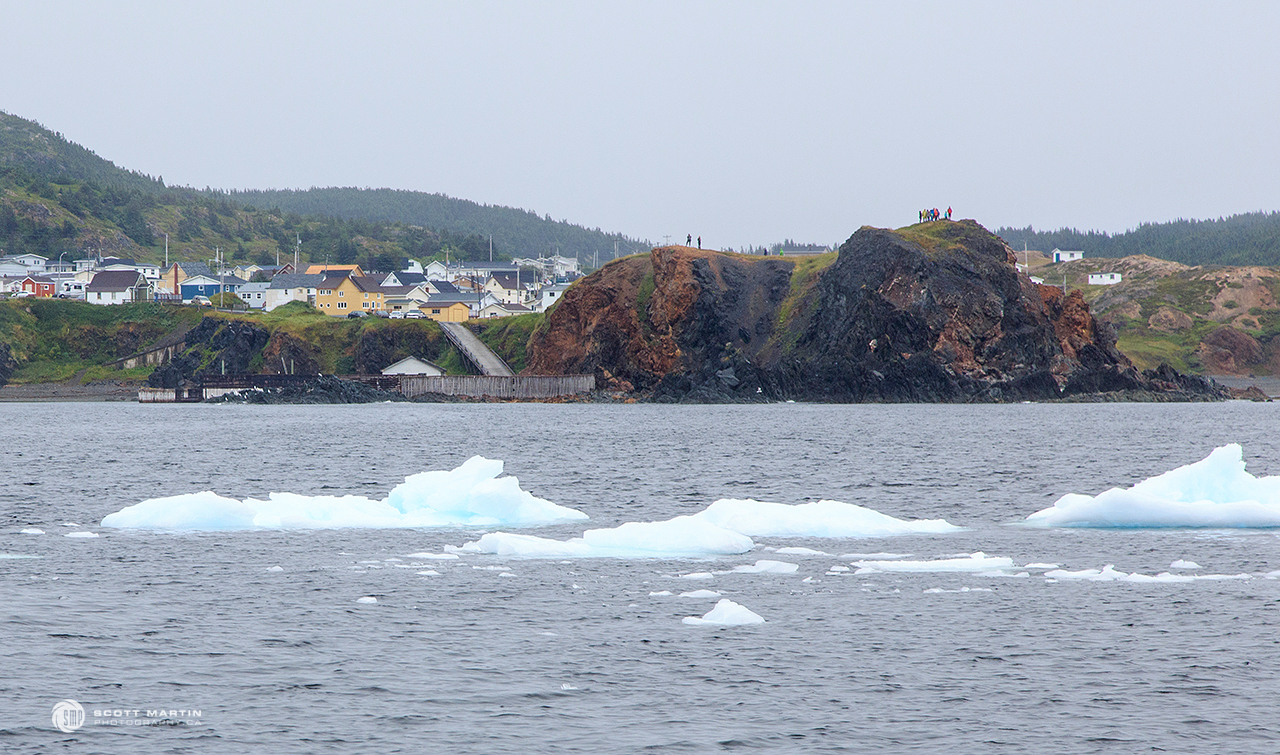
We circled around the iceberg a number of times, taking more than 500 images of it from every conceivable angle. It was hard to put the camera down!
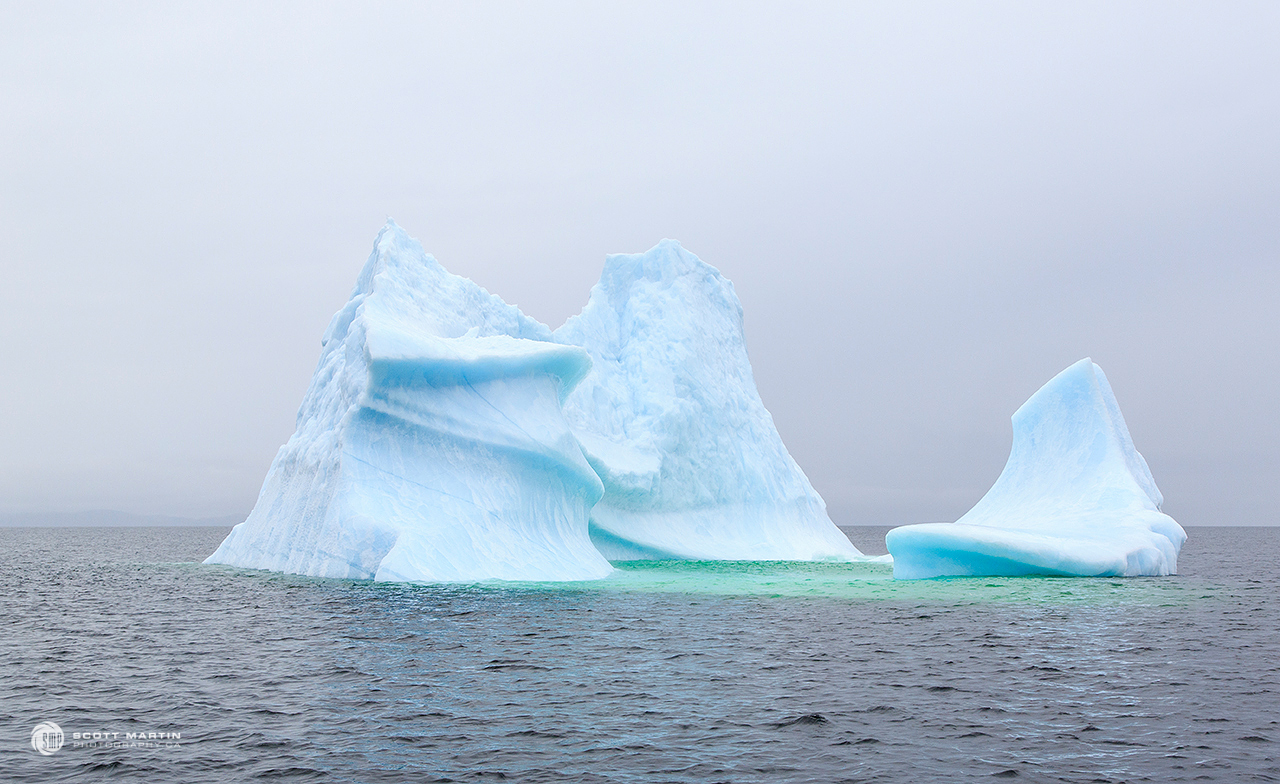
.
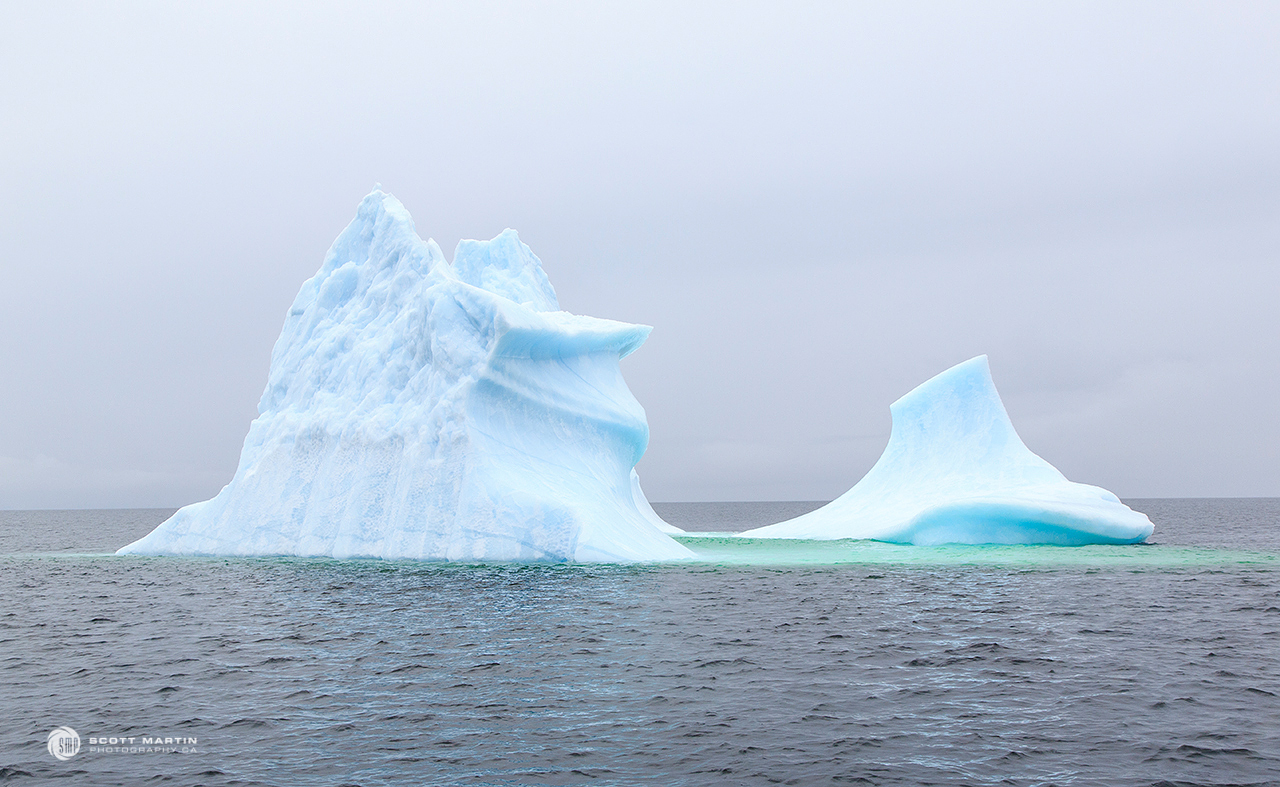
Like modern pieces of art.
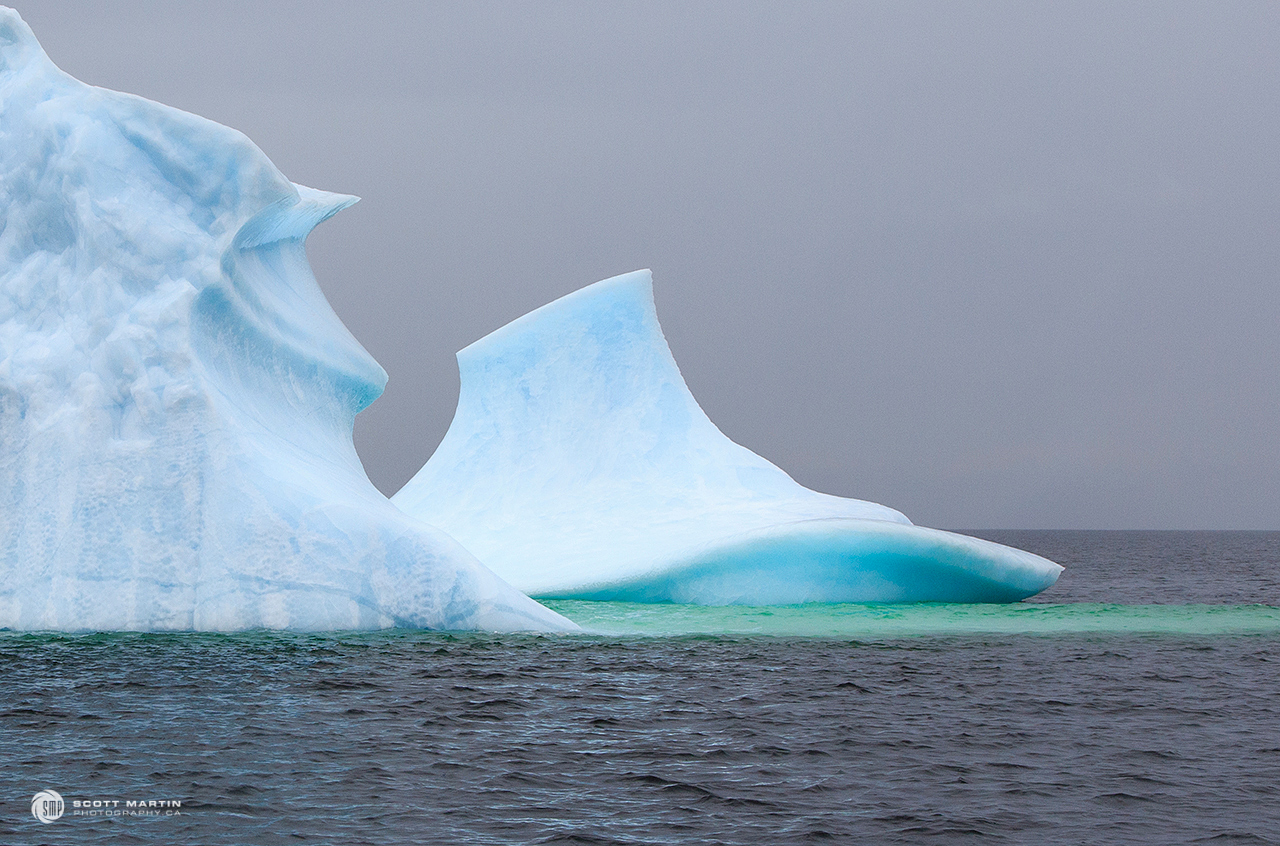
The approaching ship provides an interesting size perspective for the next image.
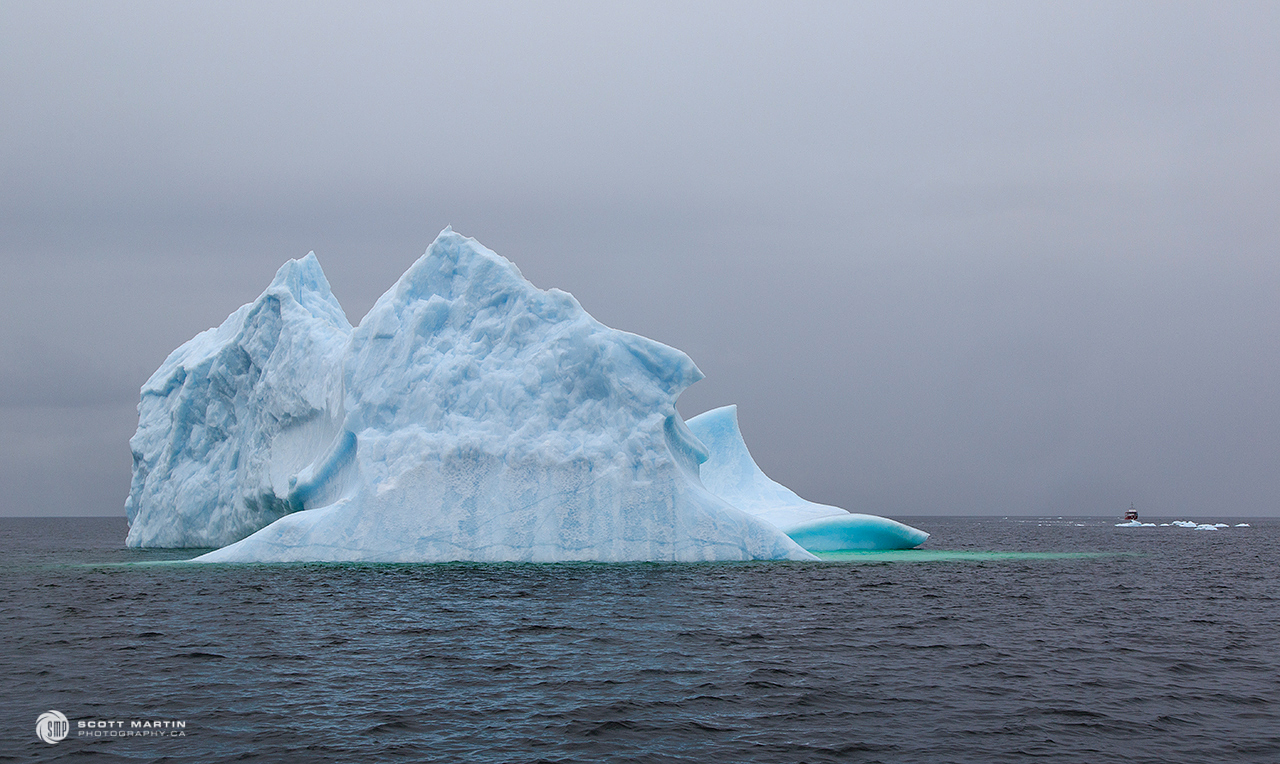
.
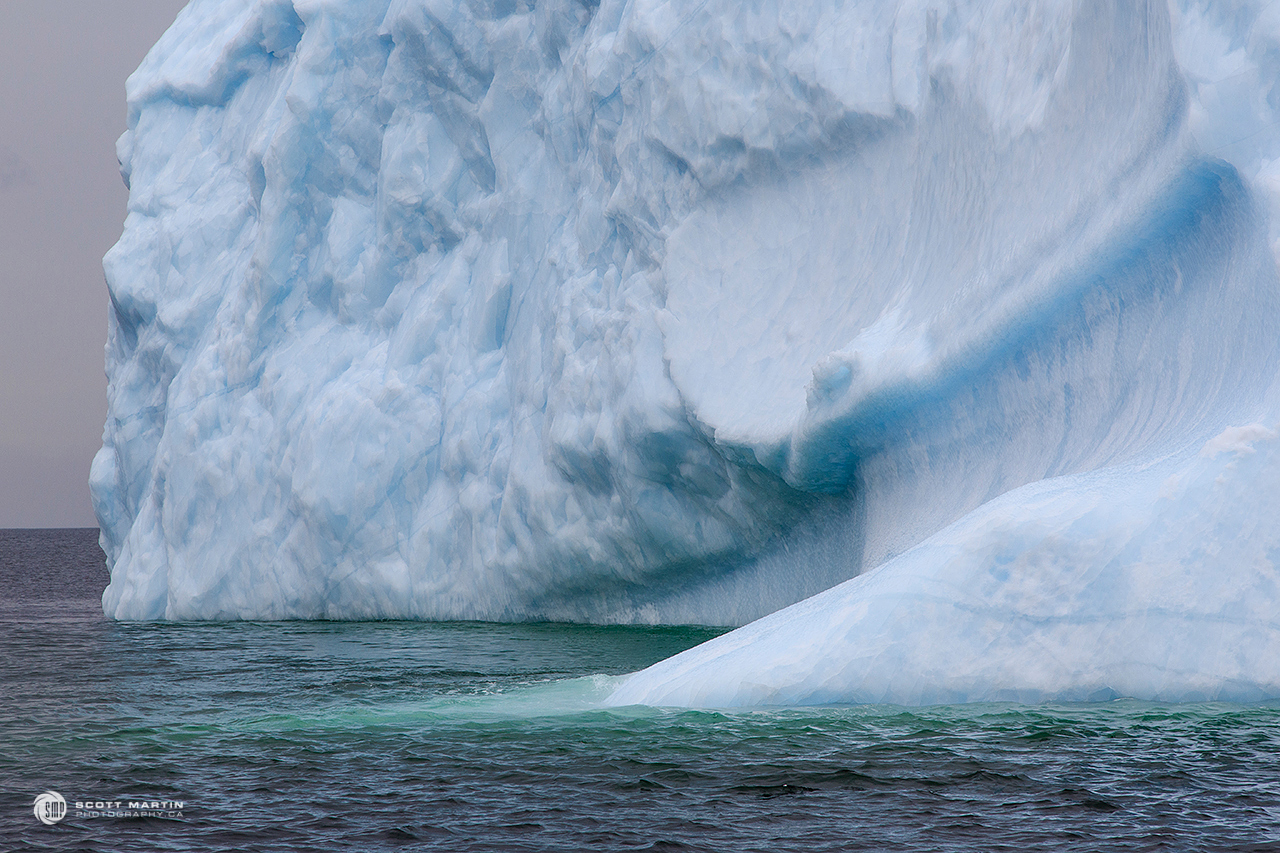
After returning to Captain Cecil’s dock in Twillingate and enjoying dinner in a little restaurant on the edge of the harbour we headed back to Crow Head to watch the sunset and see the iceberg one last time. Although we couldn’t frame the sun setting over the iceberg from the mainland, we did enjoy the colours and the new look they gave the iceberg. It was remarkable how much the iceberg had changed in ten hours.
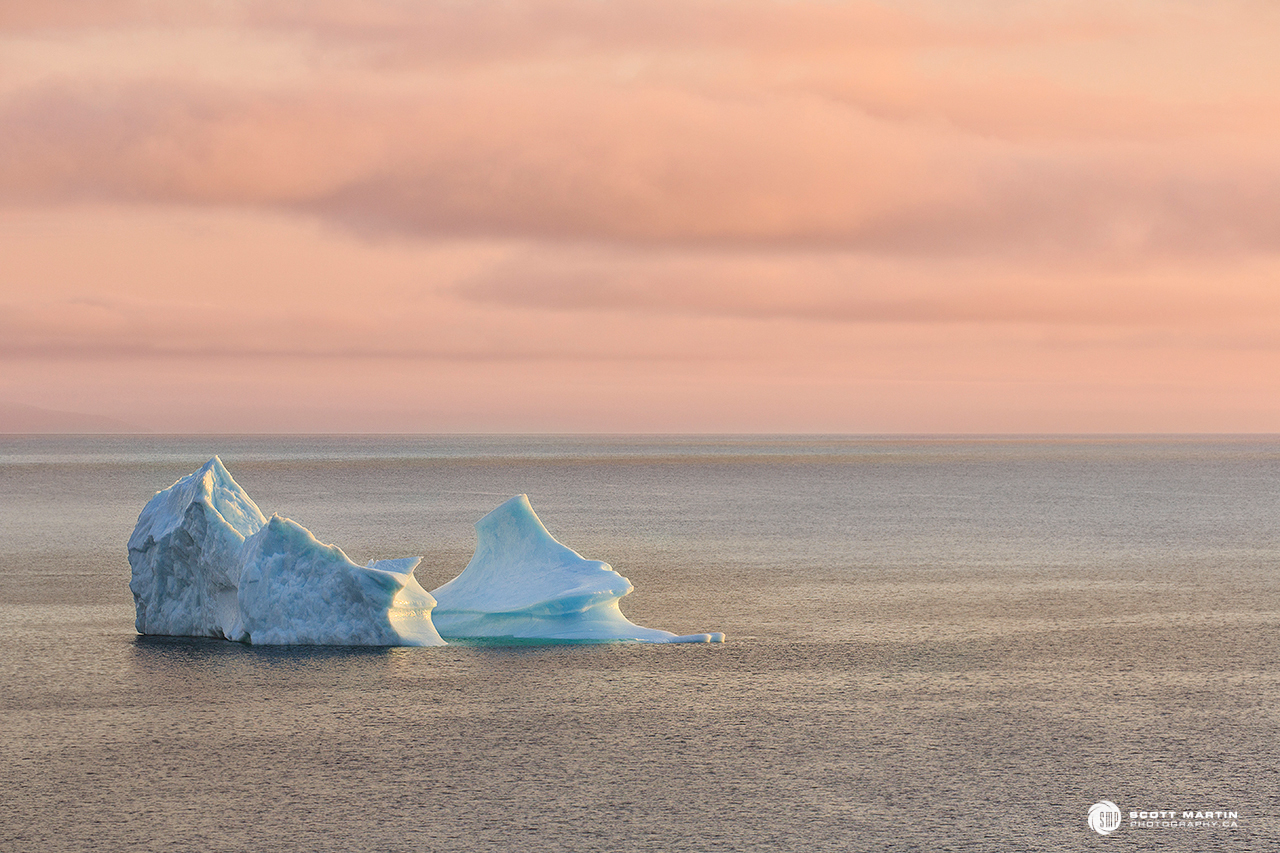
As the sun went down we were chatting with another couple and their daughter and it turned out the father & daughter were the two kayakers from earlier in the day! Ironically, as they were saying they felt more awe than fear as the large chuck of ice fell from the iceberg close to their kayaks, a loud rife sounding noise came from the iceberg and the entire iceberg began to pitch and roll quite drastically. By this time it was about thirty minutes after sunset and it was quite dark, however I just had to take some images, even though an ISO of 8000 was required.
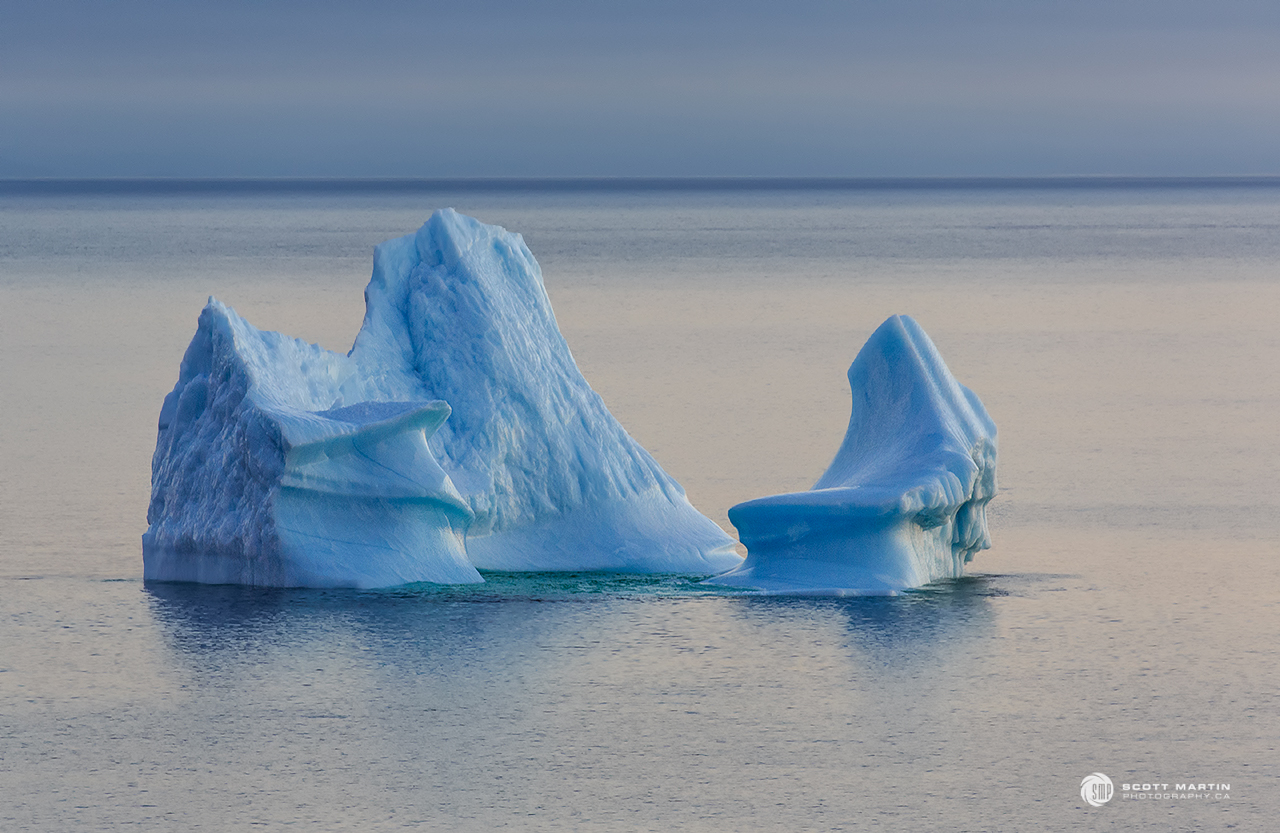
The iceberg slowly begins rotating in a clockwise direction.
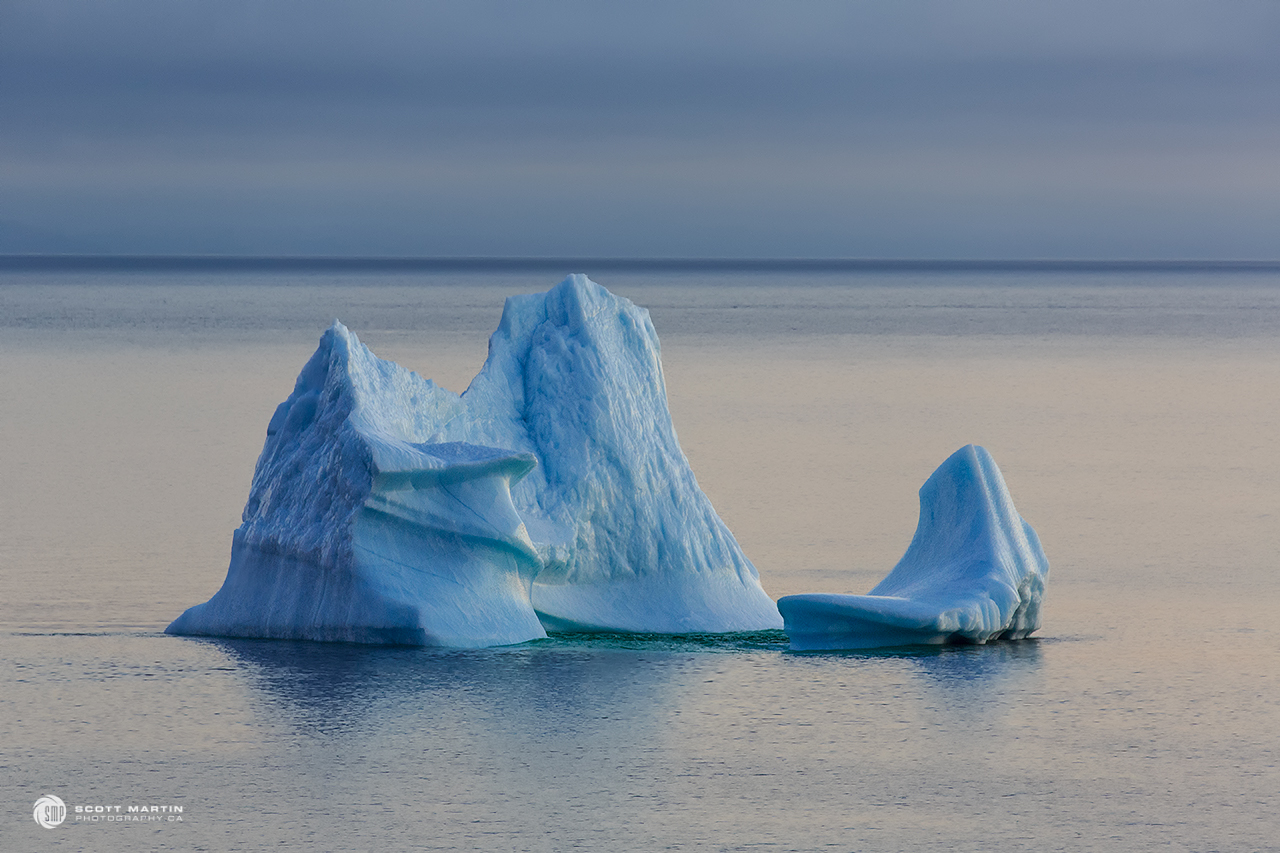
.
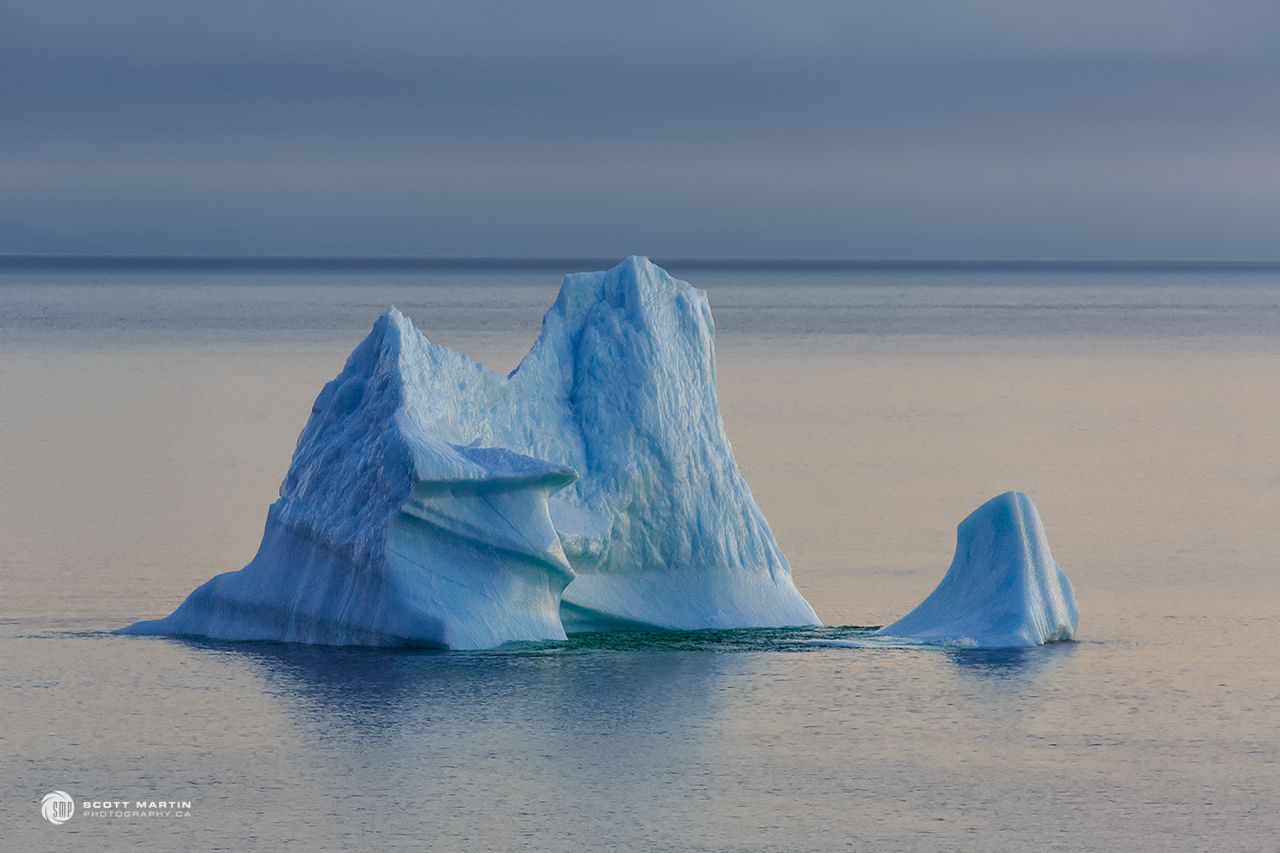
.
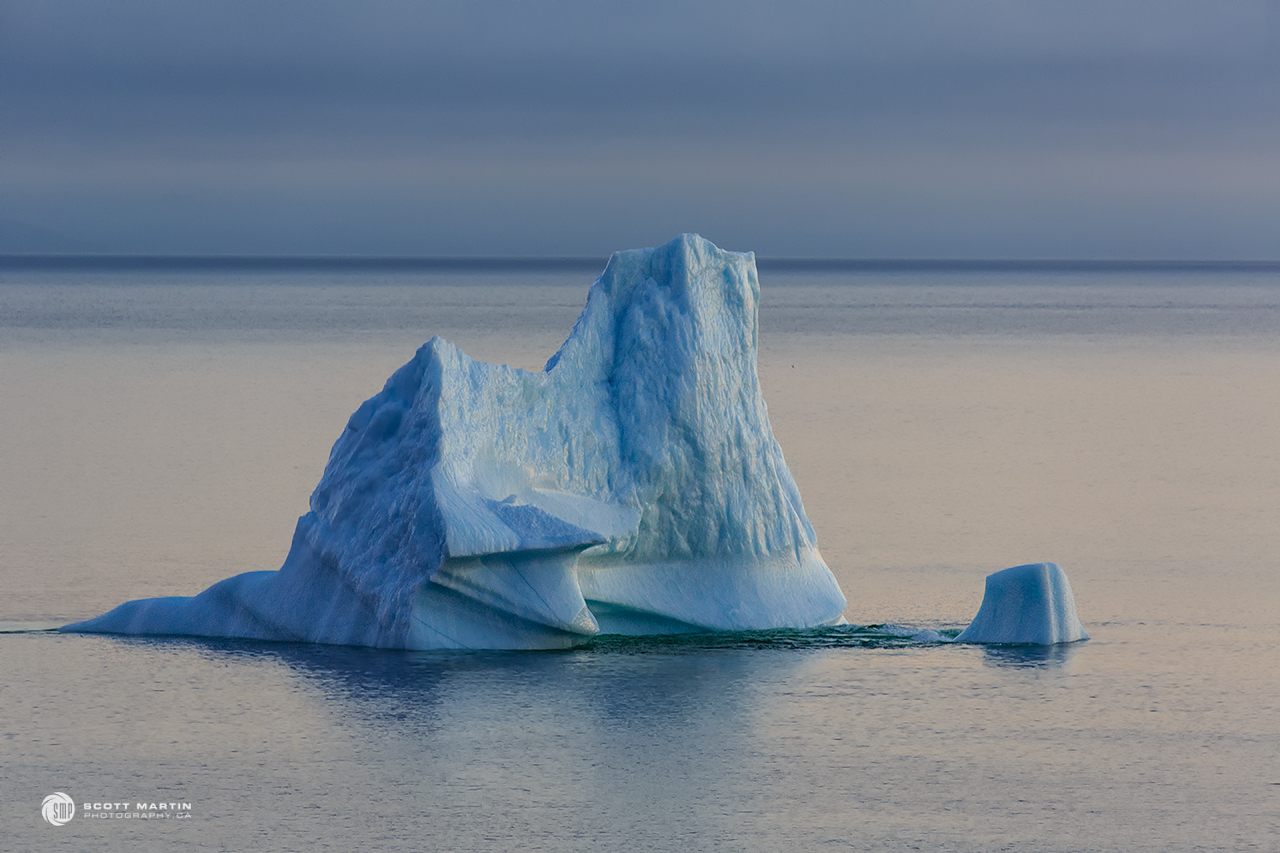
The beautiful modern art looking section of the iceberg is about to disappear forever.
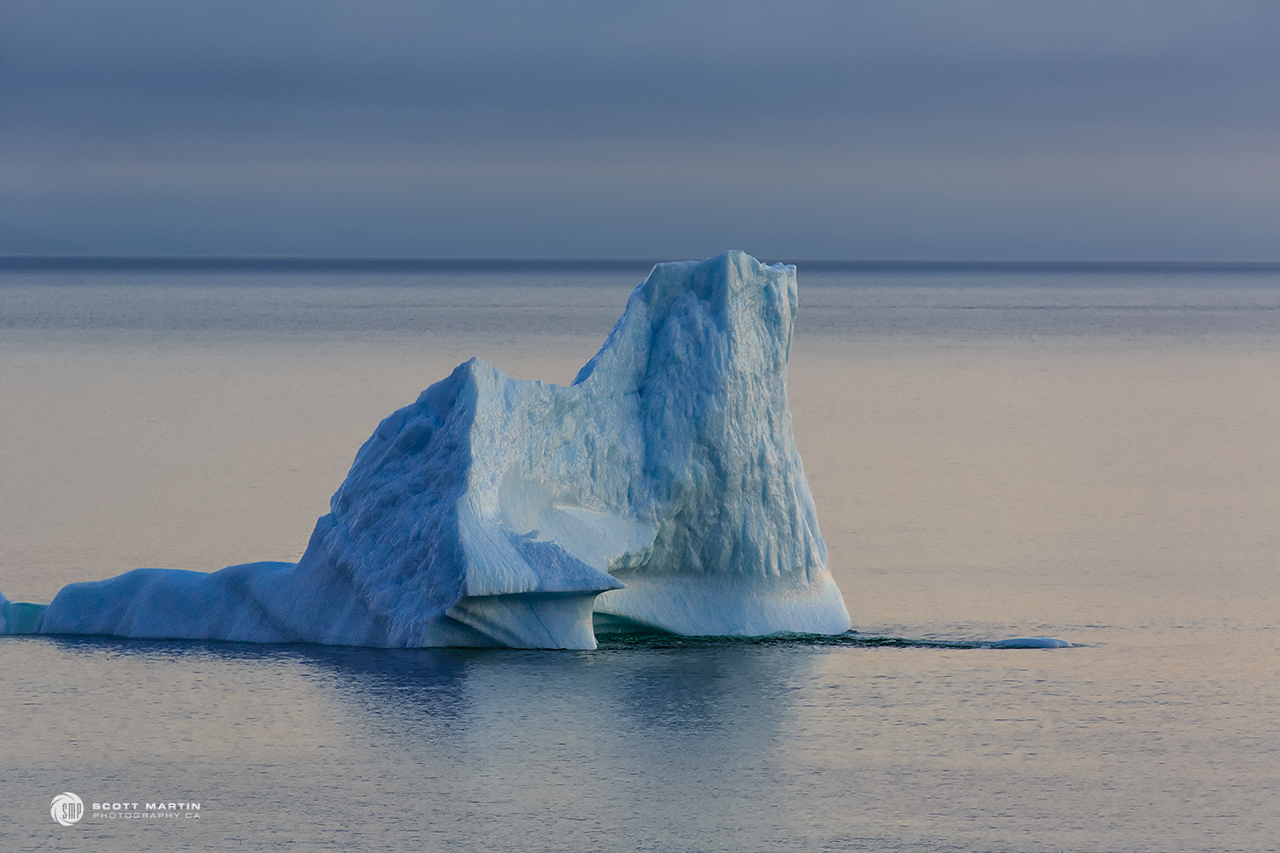
As the iceberg rotates a whole new mass of ice appears on the left side. This section was about 100′ in length.
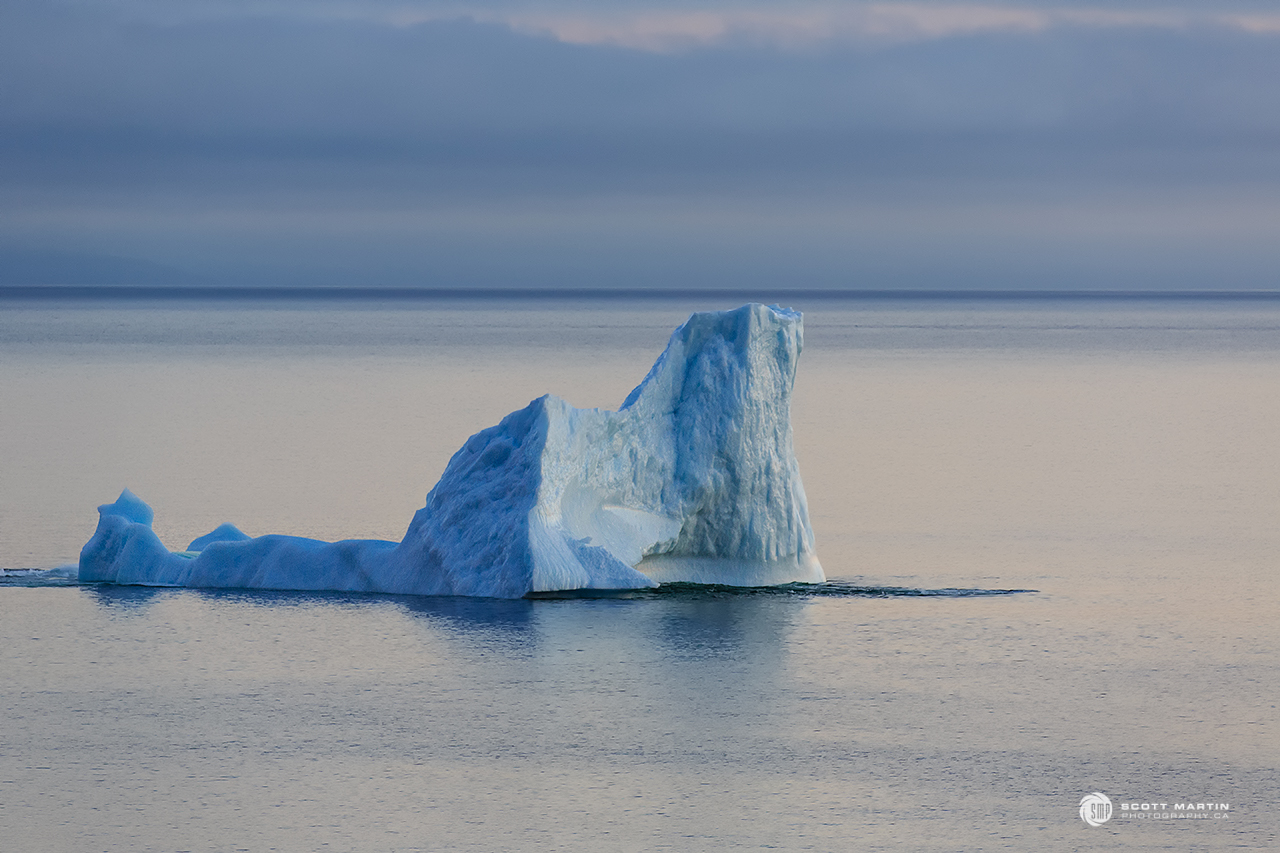
.
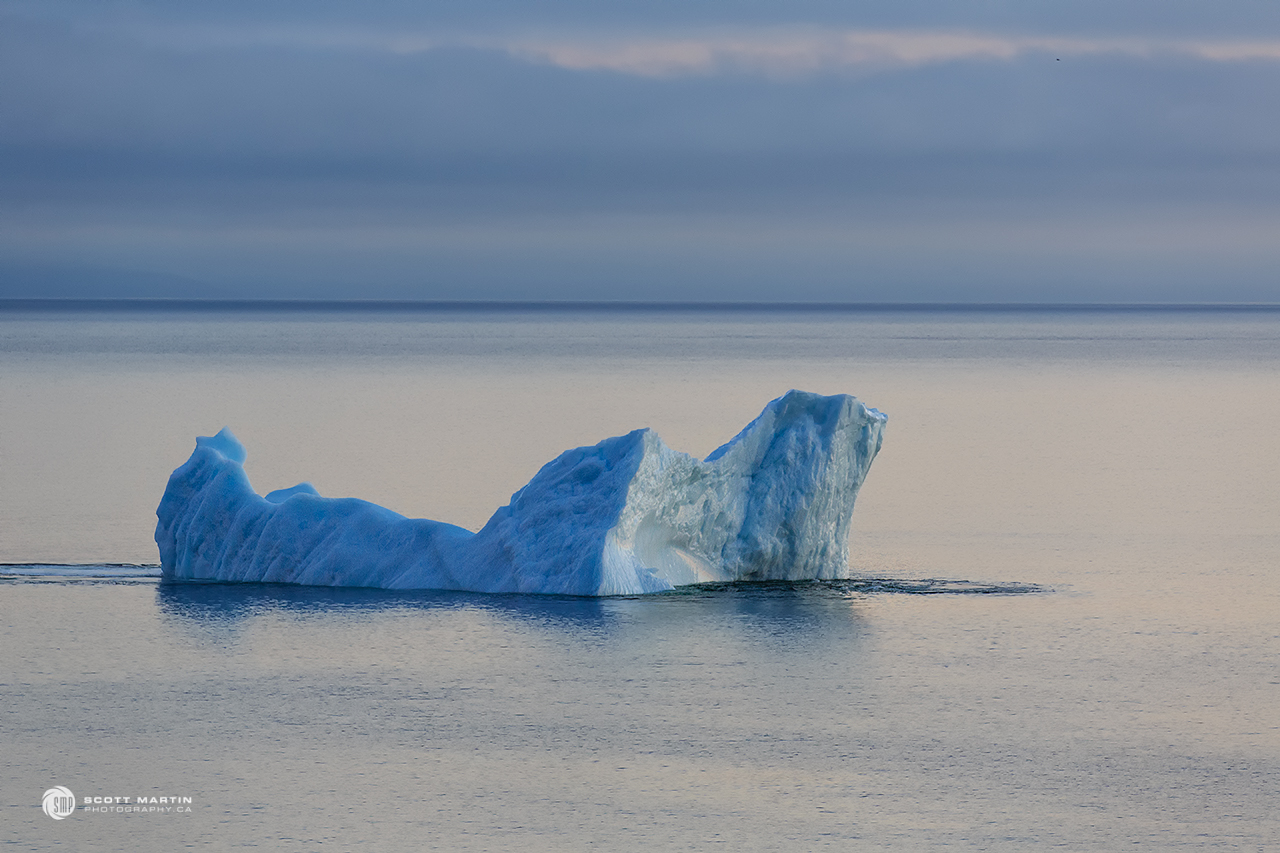
The image above shows the iceberg at its maximum rotation and now it slowly reversed its rotation and began to roll away from us. The unsettling of the iceberg caused another large pice of ice to flake off, as seen on the right side of the following image.
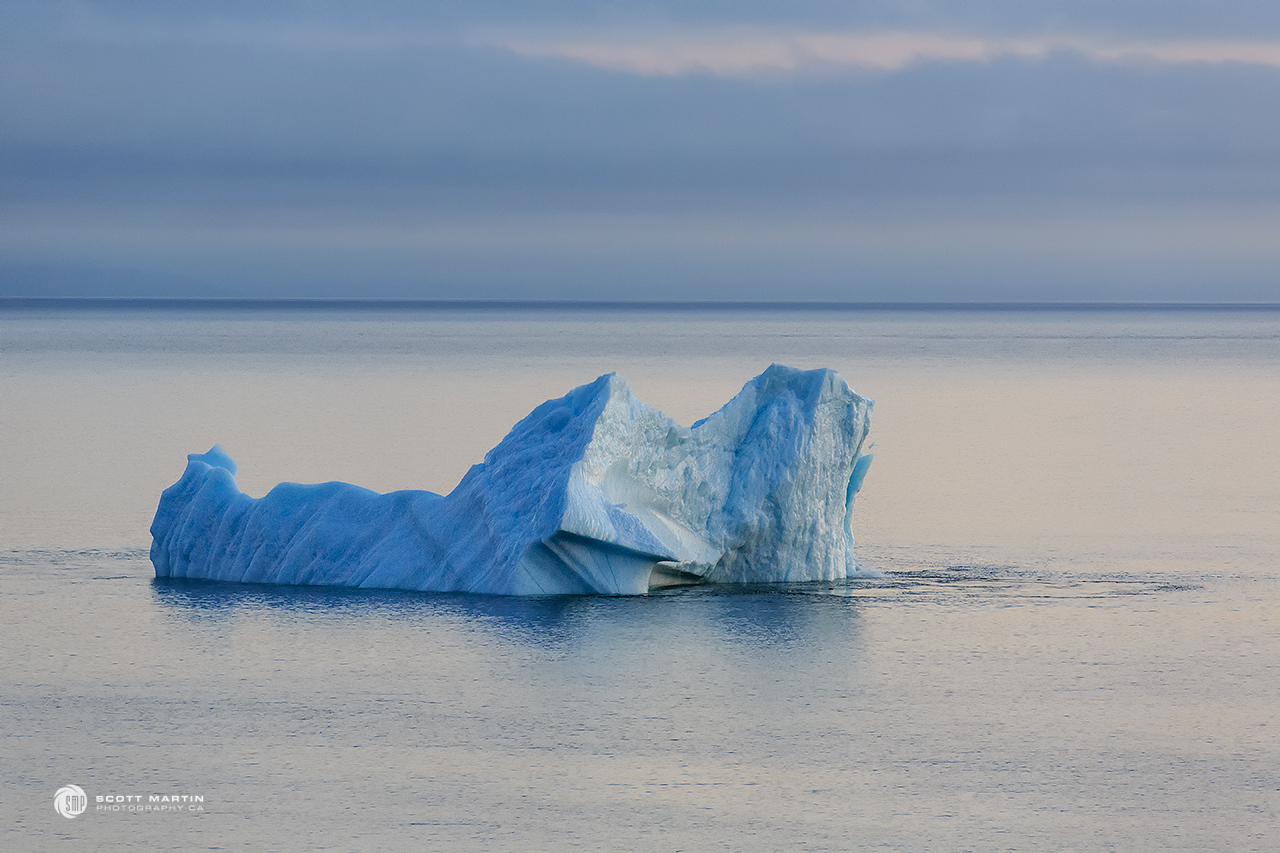
This was a huge pice of ice, at least thirty feet in height. The sound of the fragmentation and ensuing splash was a unique and unforgettable sound.
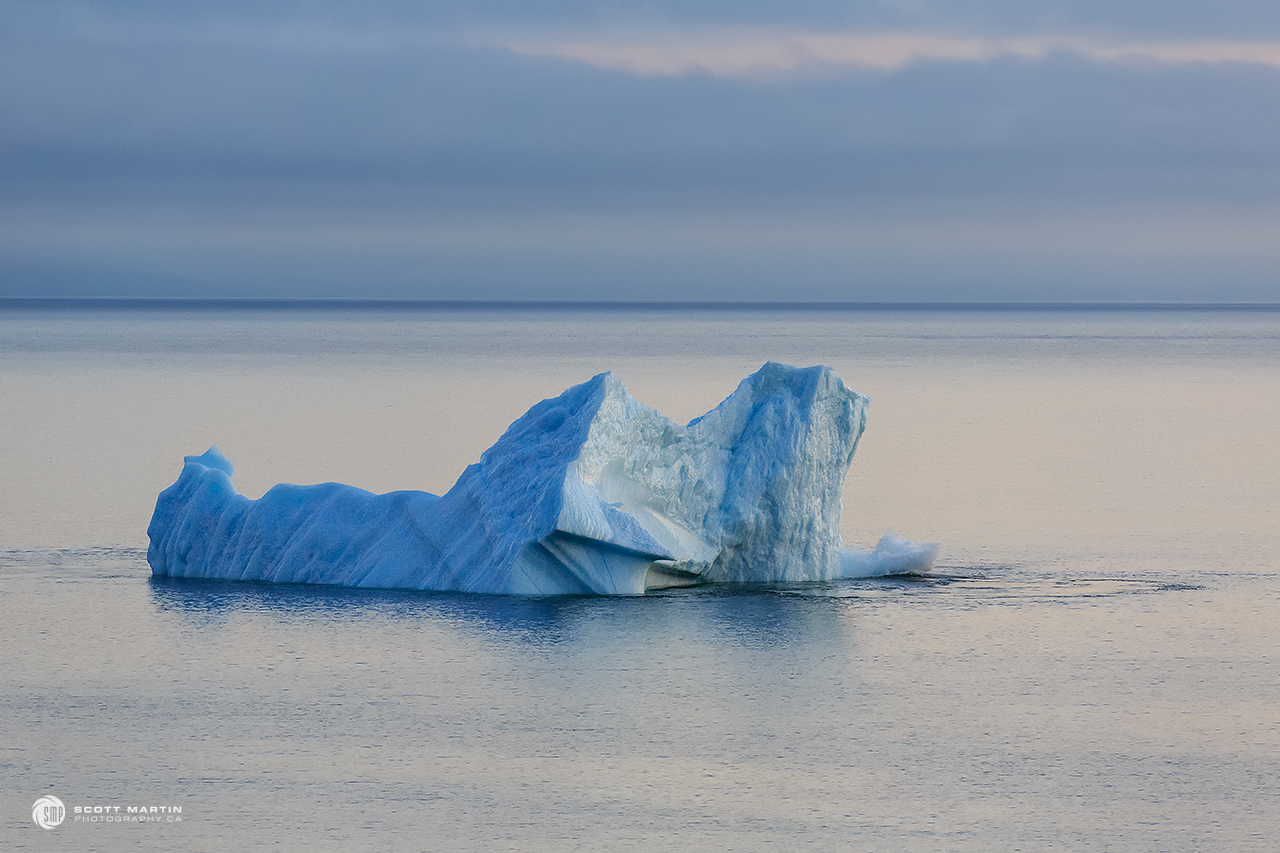
.
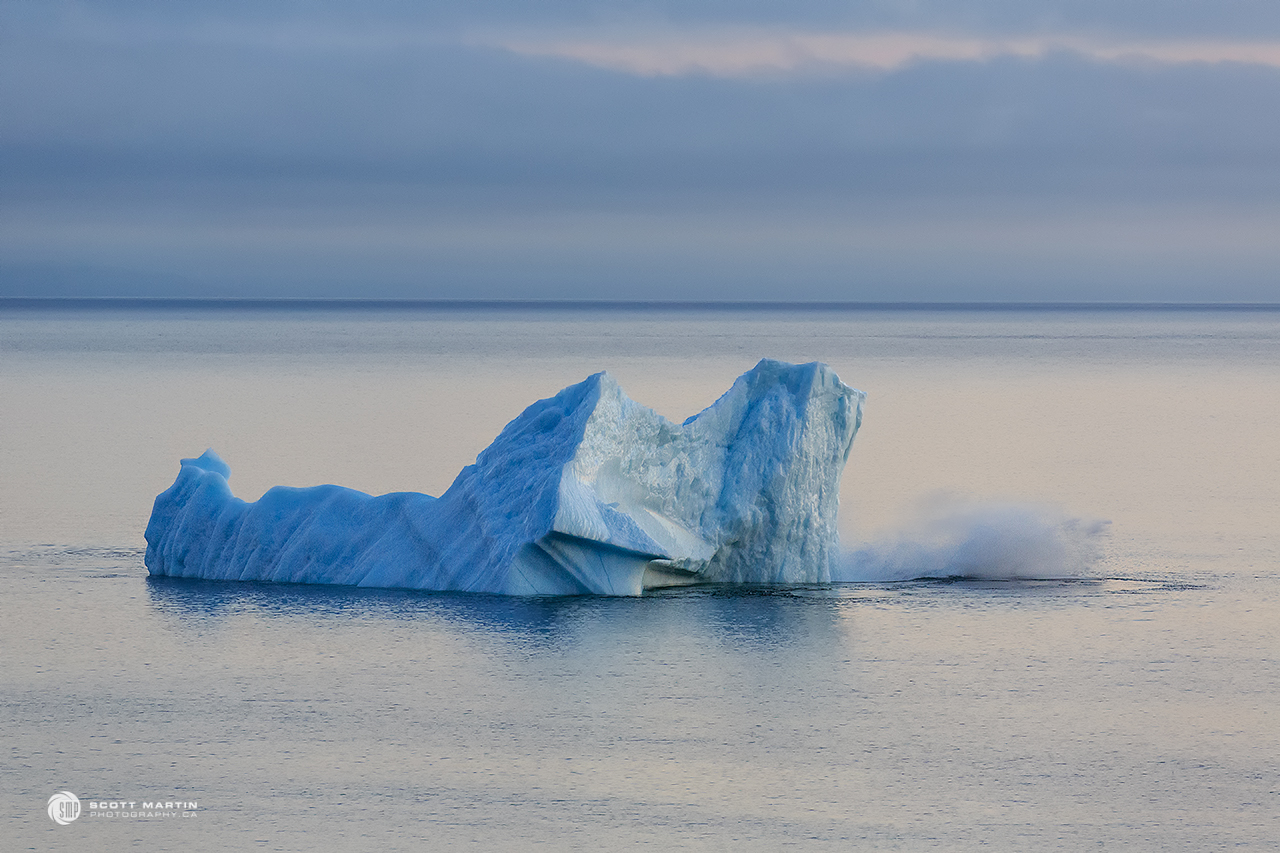
After the enormous splash, the iceberg silenced and the surrounding waters calmed.
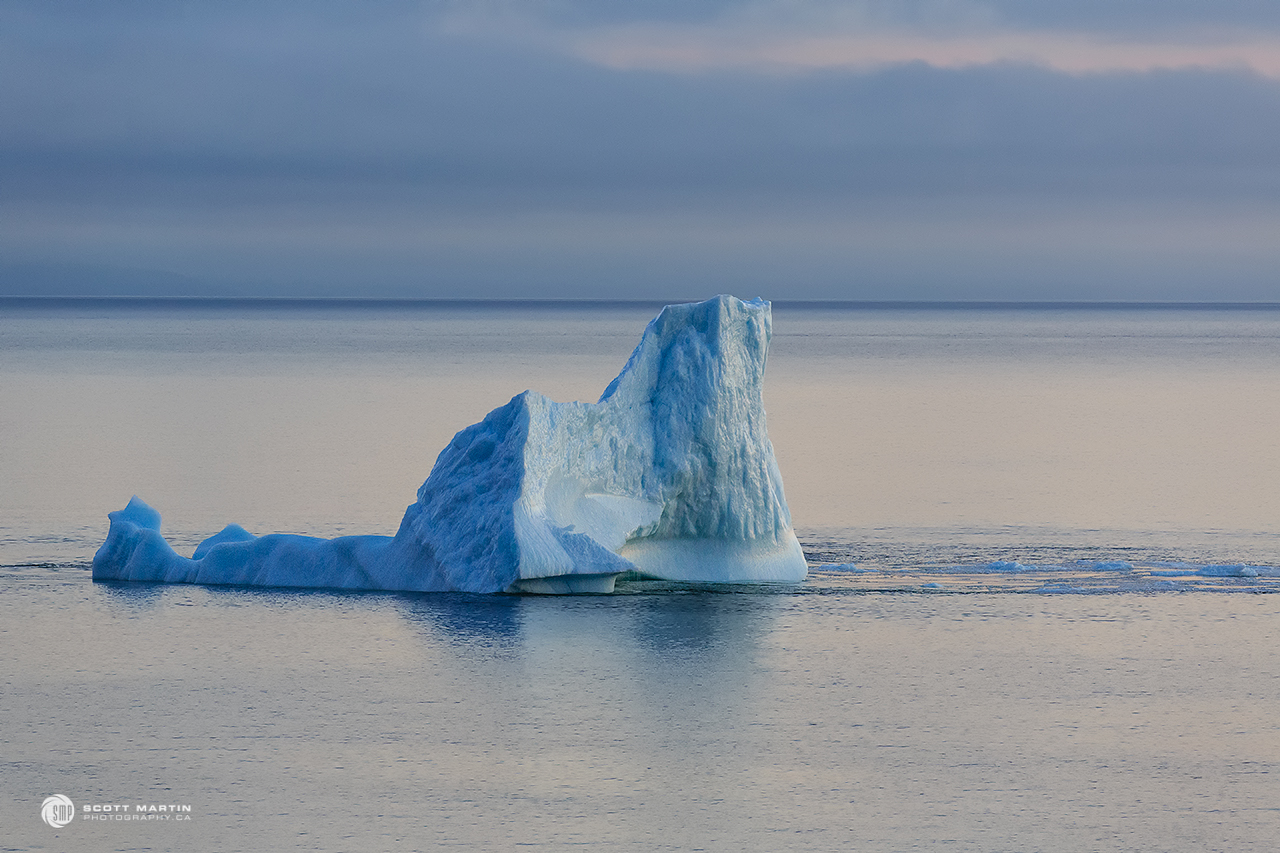
The previous images were taken over approximately ten minutes and by the end of that time the iceberg had loosed itself from the ocean floor 580′ below and slowly started drifting out into the North Atlantic. All of the images in the previous sequence were taken with the camera on a tripod so you can get a sense of how much the iceberg was moving by comparing its profile against the horizon.
When we left our hotel early in the morning, Deb & I had no idea we would be spending the entire day watching an iceberg, but what a day it was. Never having seen an iceberg before and then watching it break apart over the day and move out to sea was a highlight of the trip. We highly recommend when travelling to ‘The Rock’ that you schedule a time of the year you are likely to see some icebergs. They will never disappoint.
More images of icebergs can be found in the Iceberg Gallery while images from ‘The Rock’ can be found in the Newfoundland Gallery.
If you haven’t already done so, please subscribe to the blog and receive notification of future blog posts. The next two or three will be centred on Newfoundland; its rugged geography, old light houses, Puffins and Humpback Whales!
As we come to the end of another year, I’d like to thank all of you who have followed the blog. Your comments, support and encouragement are much appreciated. From our family to yours, a very Merry Christmas and Happy New Year.









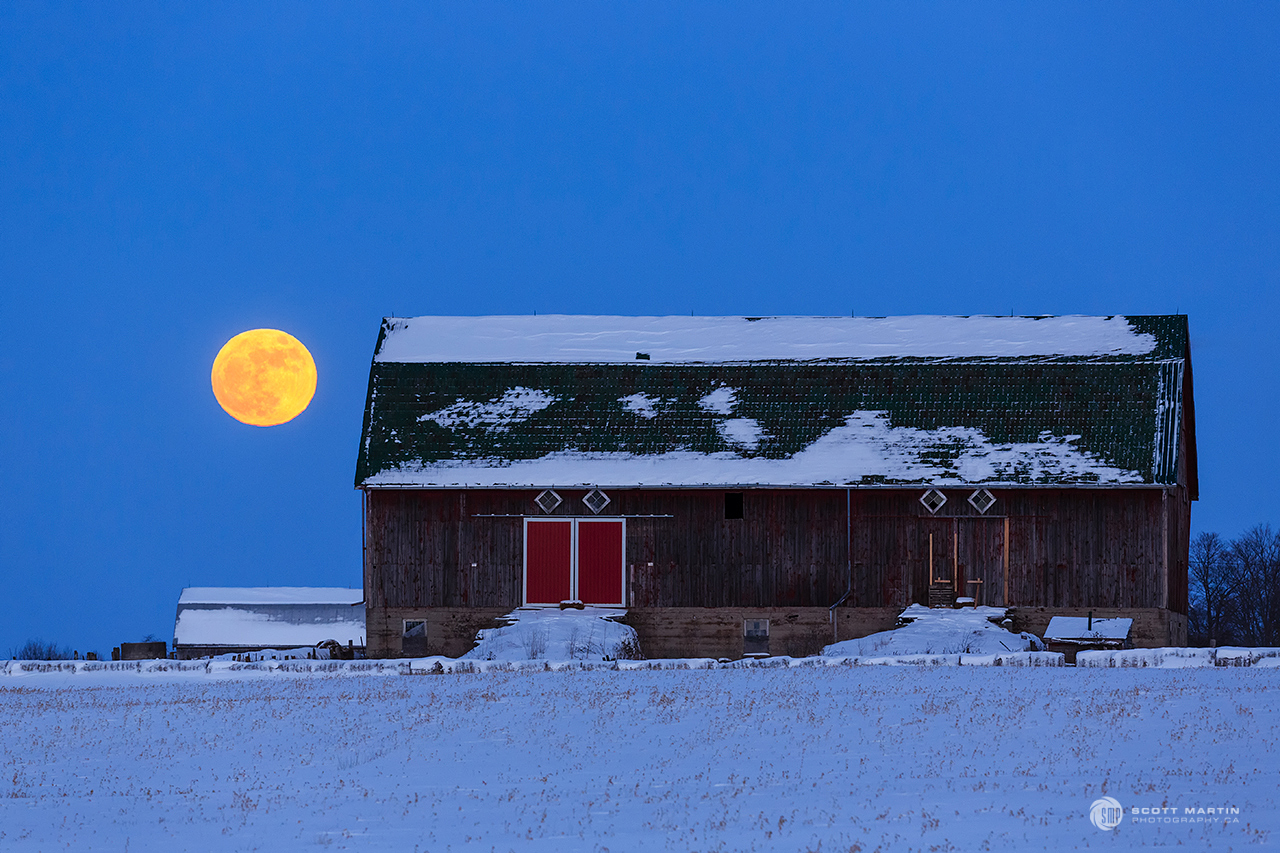
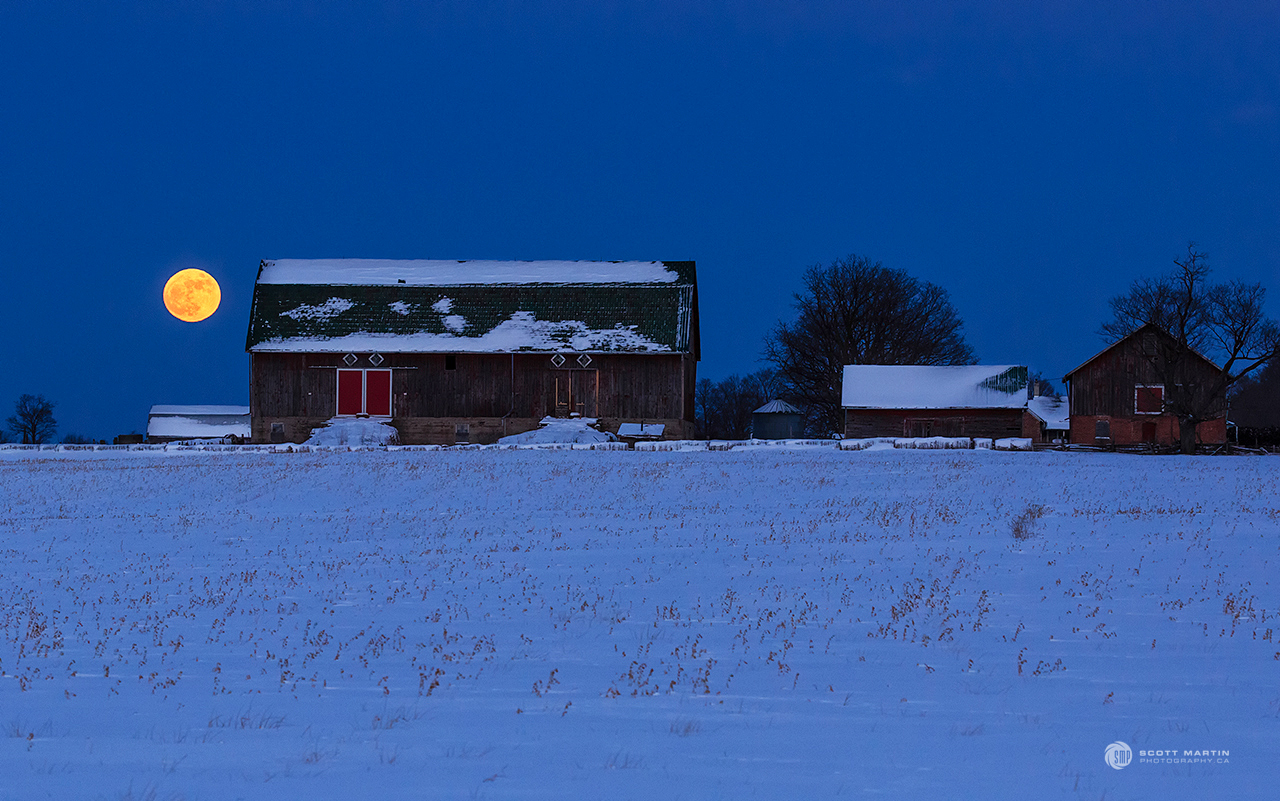
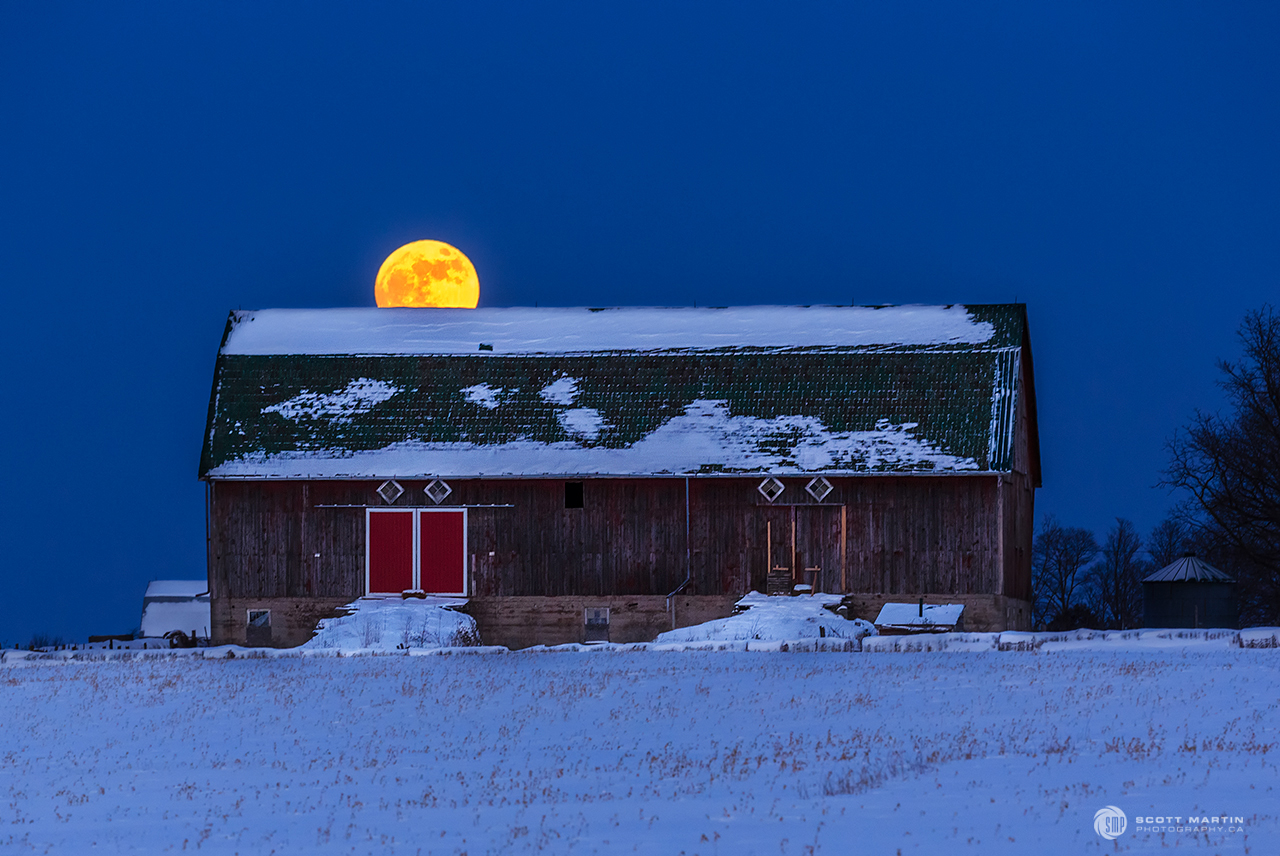
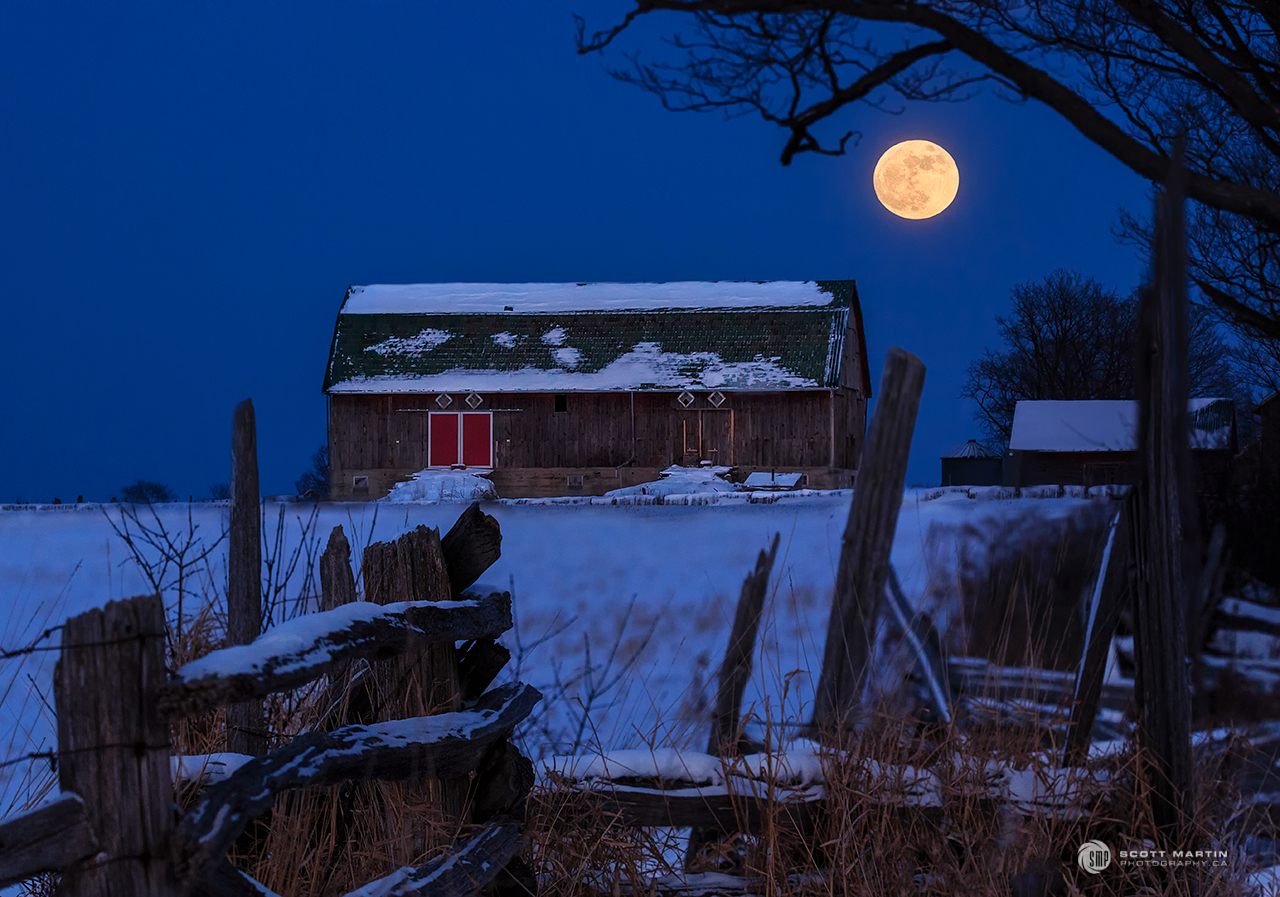







































Follow Scott Martin Photography